Simulation of Climate Change Impact on A Coastal Aquifer under Arid Climate. The Tadjourah Aquifer (Republic of Djibouti, Horn of Africa)
Abstract
:1. Introduction
- -
- simulate rainfall series up to 2100 at the scale of RoD using climate scenarios made available by IPCC;
- -
- deduce groundwater recharge based on the simulated rainfall series;
- -
- model the studied aquifer, using the recharge series as the input;
- -
- analyze the aquifer reaction to the climate scenarios.
2. Materials and Methods
2.1. Study Area
2.1.1. Geological Setting
2.1.2. Hydrography
2.1.3. Hydrogeology
2.1.4. Exploitation of the Aquifer
2.1.5. Meteorological Data
2.2. Climate Change Scenarios
2.3. The SEAWAT Software
3. Results and Discussions
3.1. Conceptual Model of the Aquifer
3.2. Calculation of the Equilibrium State
3.3. Simulation of Climate Change Impact up to 2100 under RCP Scenarios 2.6, 4.5 and 8.5.
4. Summary and Conclusions
Author Contributions
Funding
Acknowledgments
Conflicts of Interest
Appendix A. Calibration of the Model
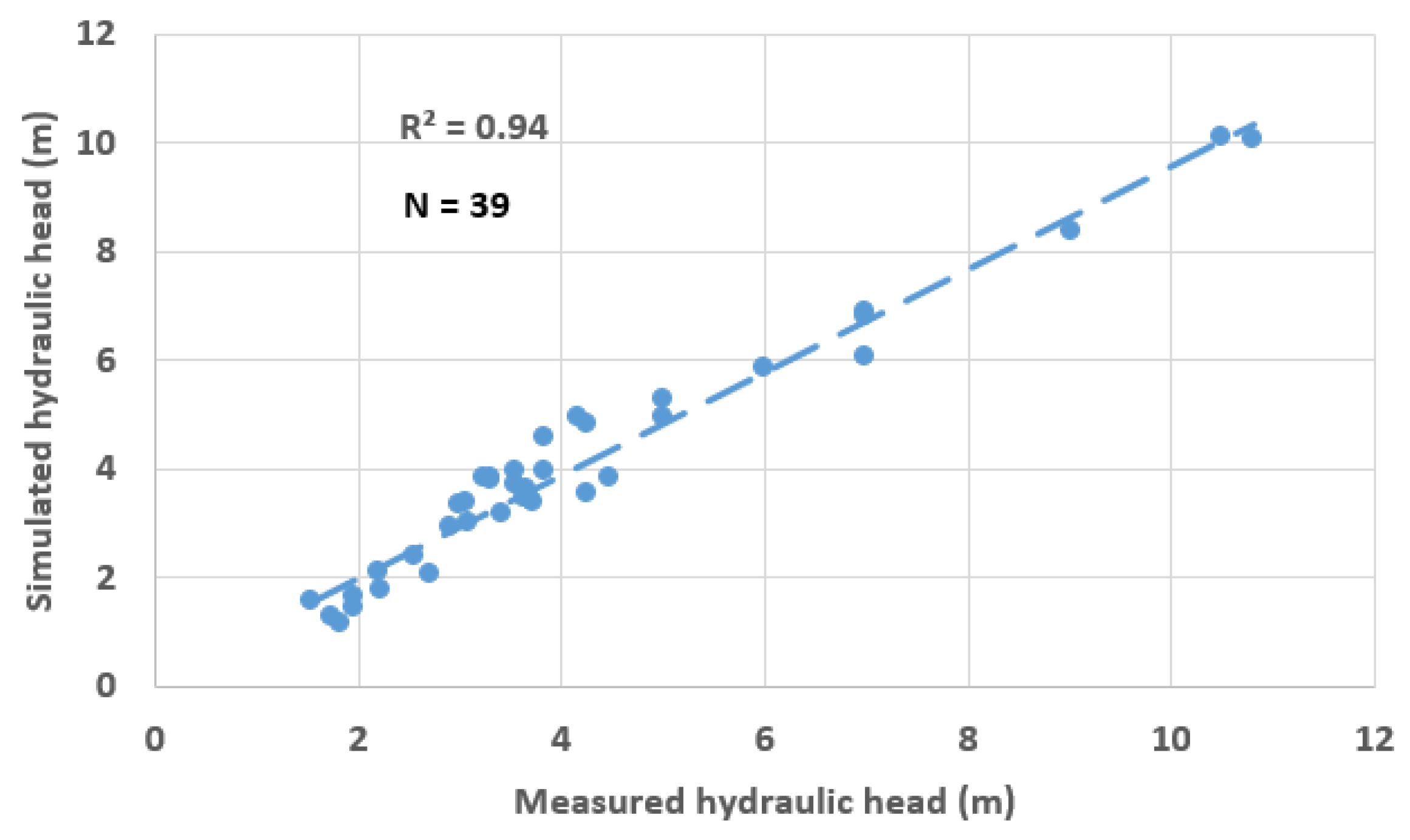
| Determination Coefficient | Mean Error (m) | Mean Absolute Error (m) | Root Mean Square Error (m) |
|---|---|---|---|
| 0.94 | 0.16 | 0.45 | 0.54 |
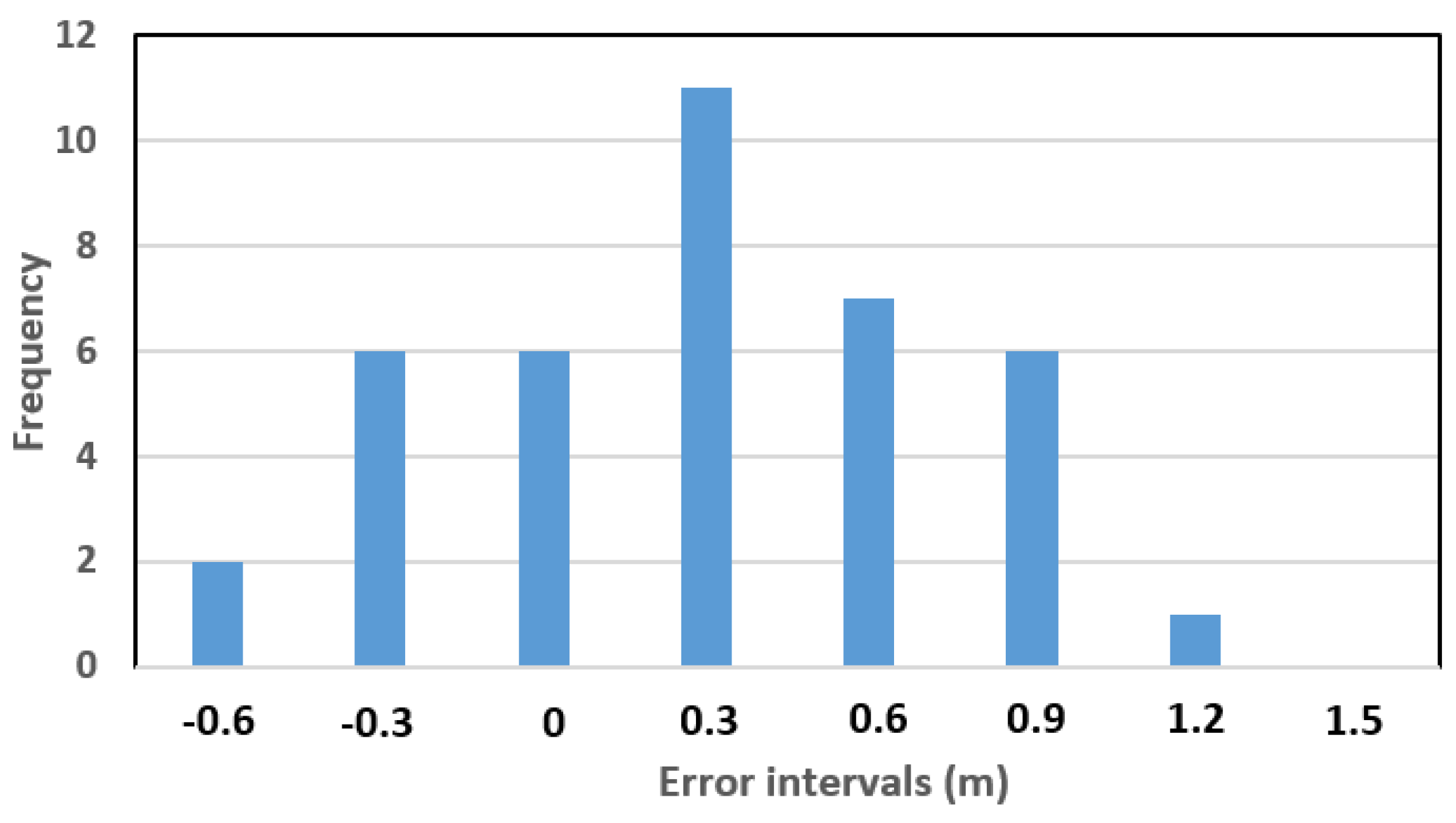
Appendix B. Simulation of Climate Change Impact up to 2100 under RCP Scenario 4.5

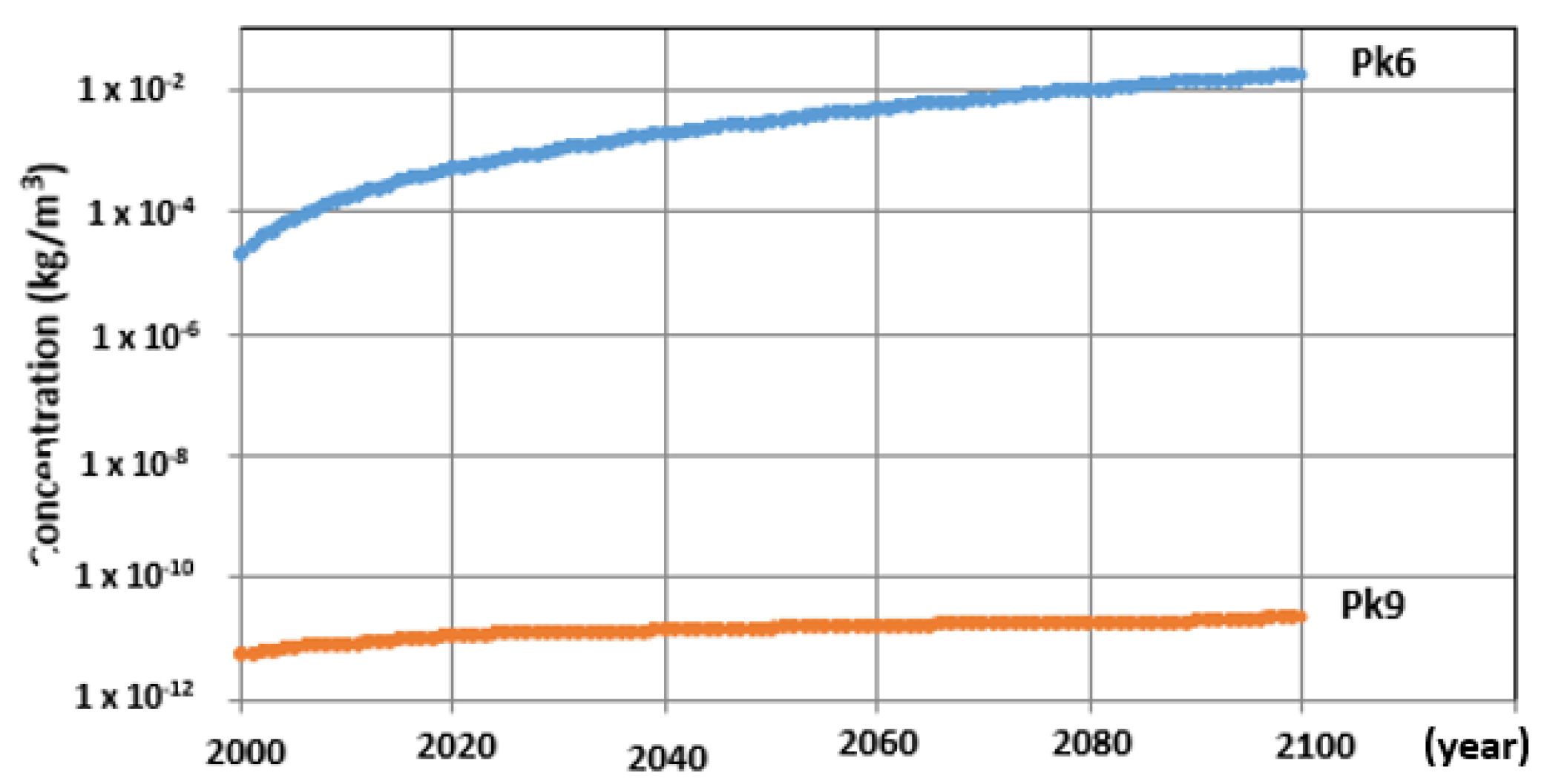
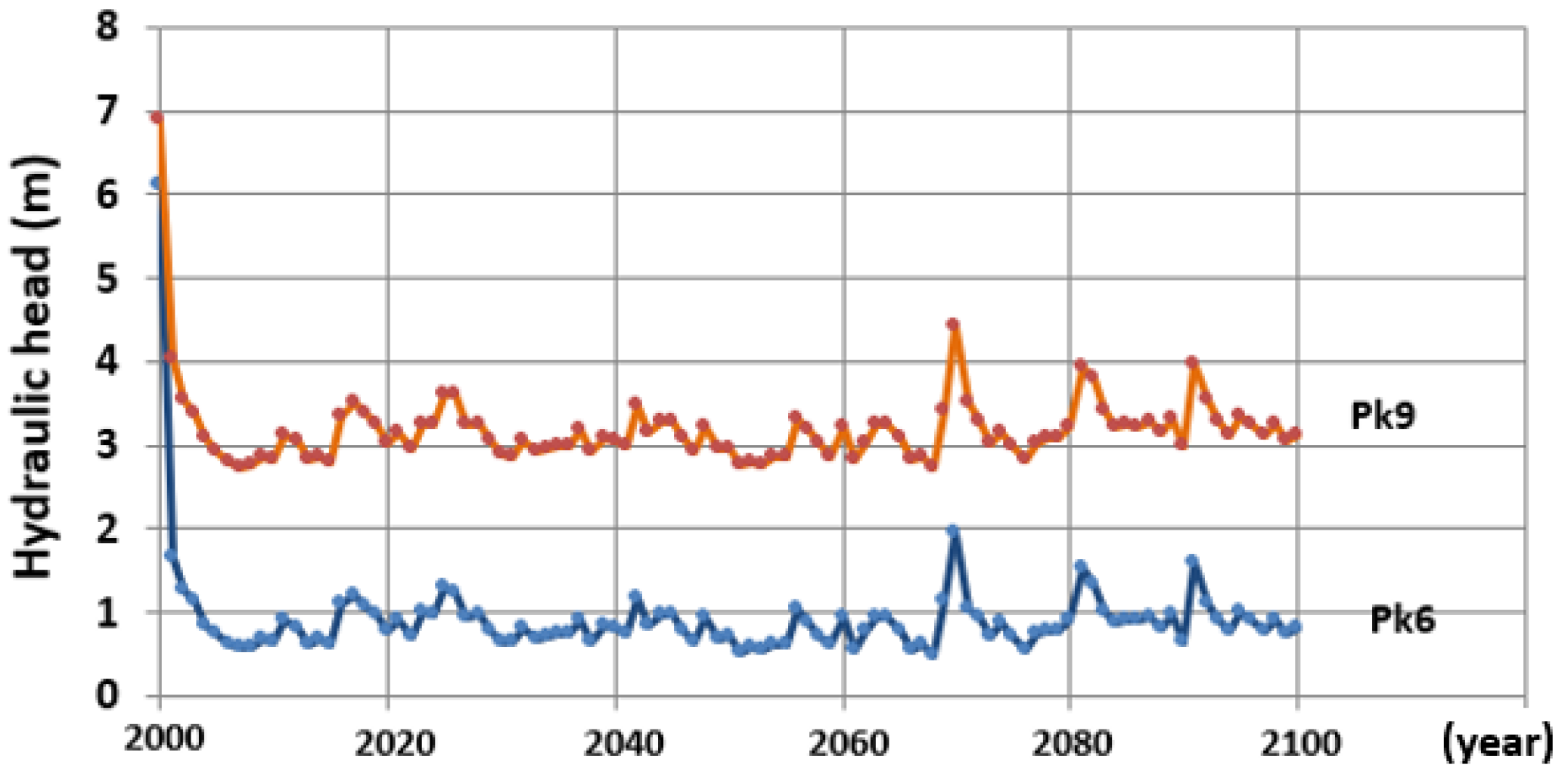
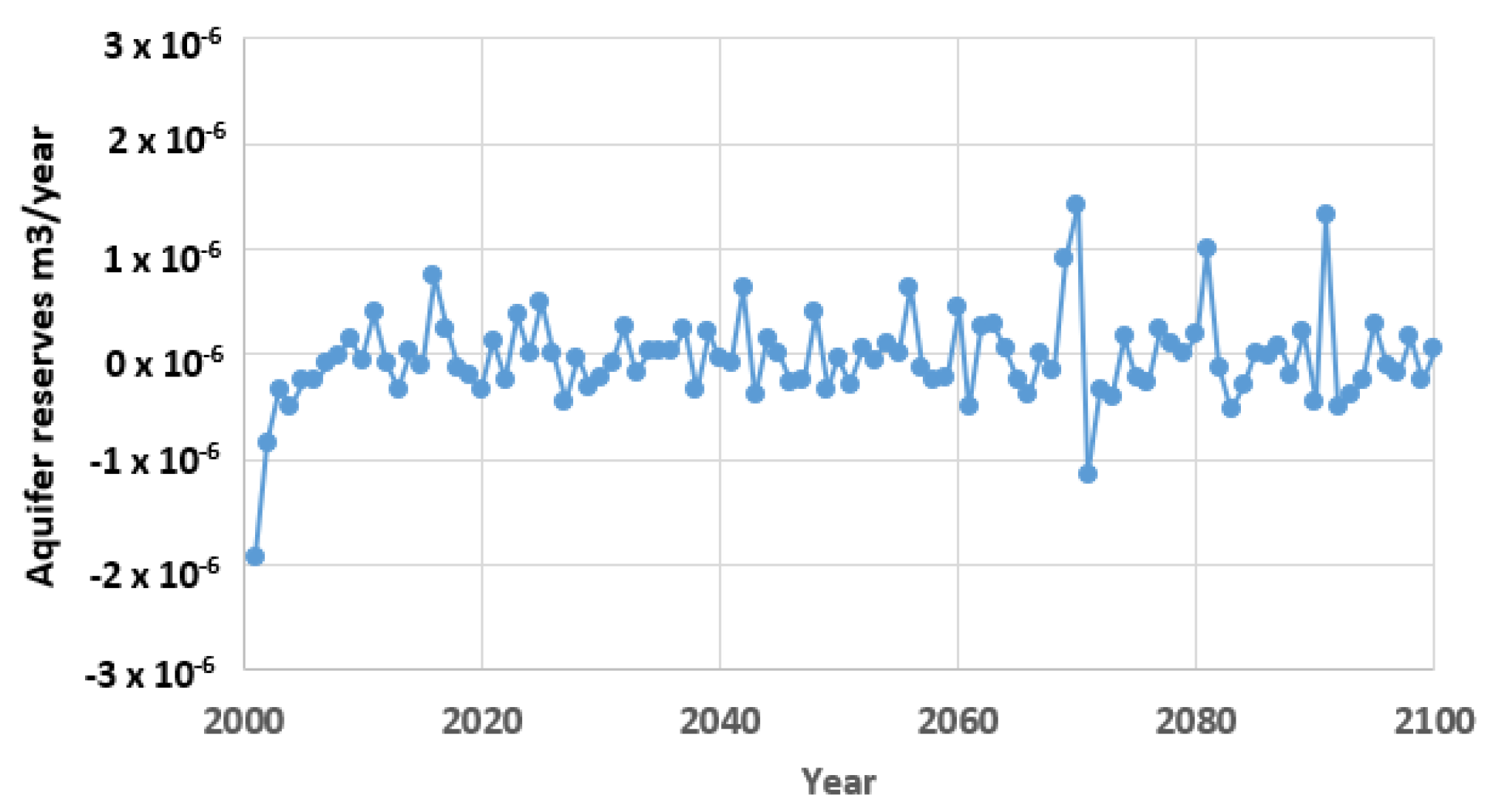
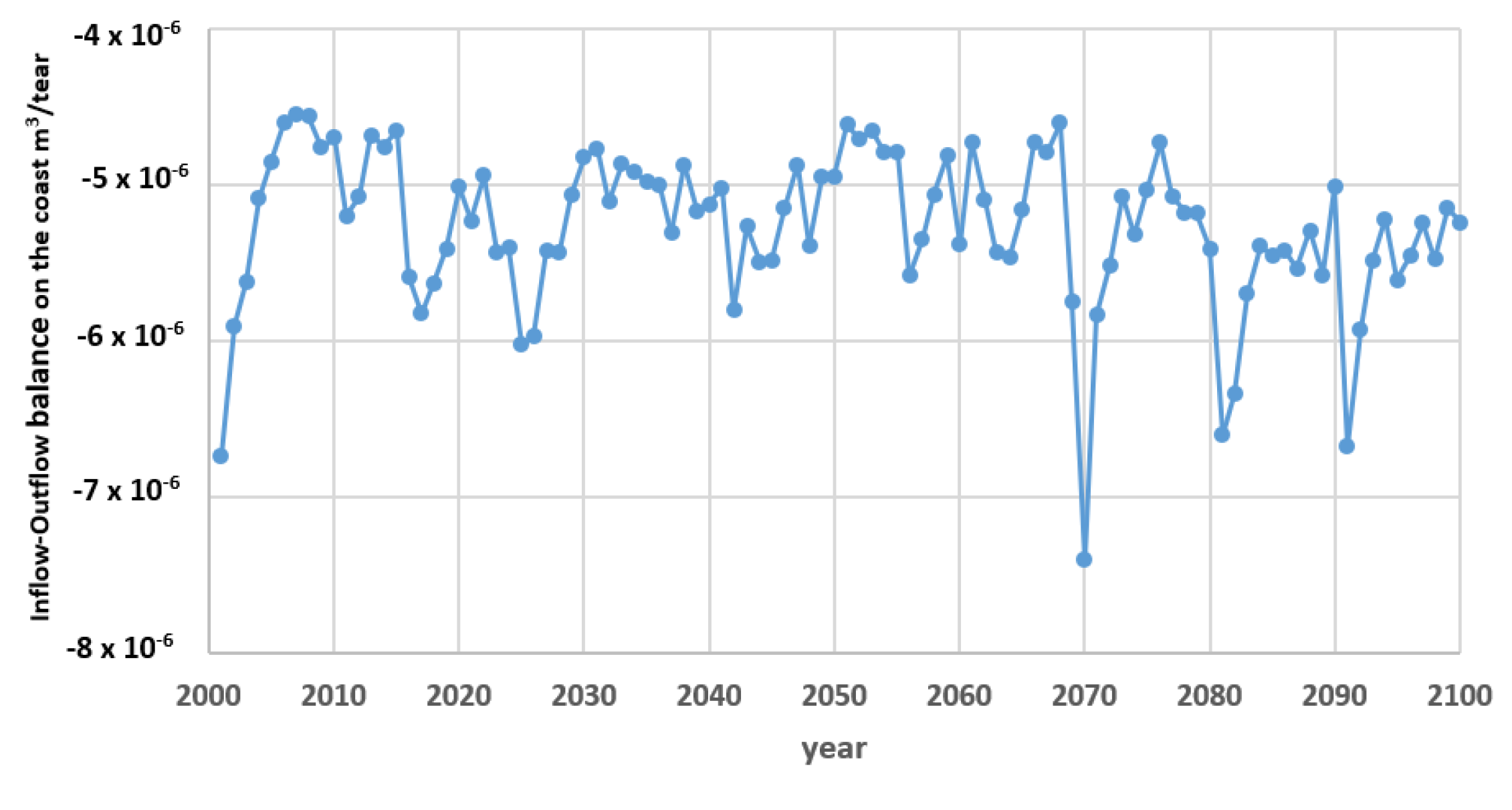
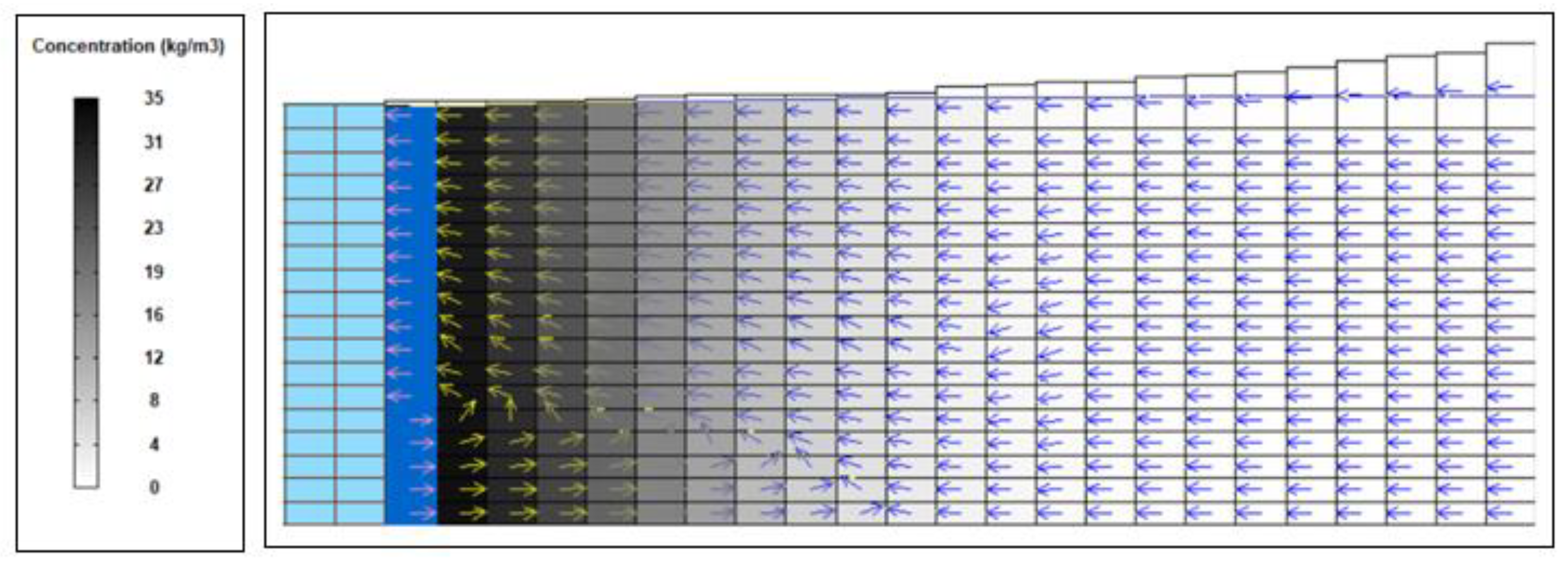
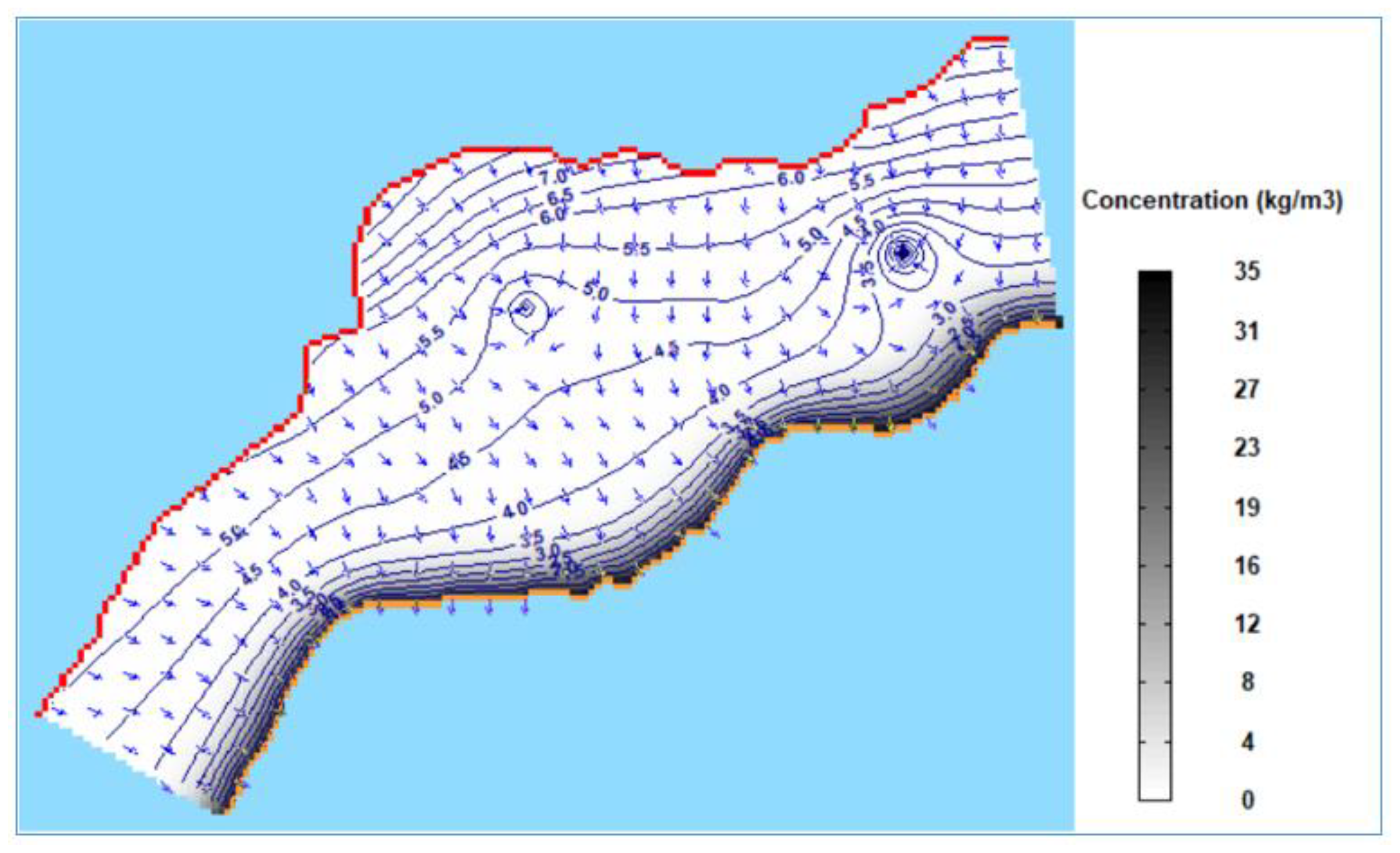
Appendix C. Simulation of Climate Change Impact up to 2100 under RCP Scenario 8.5


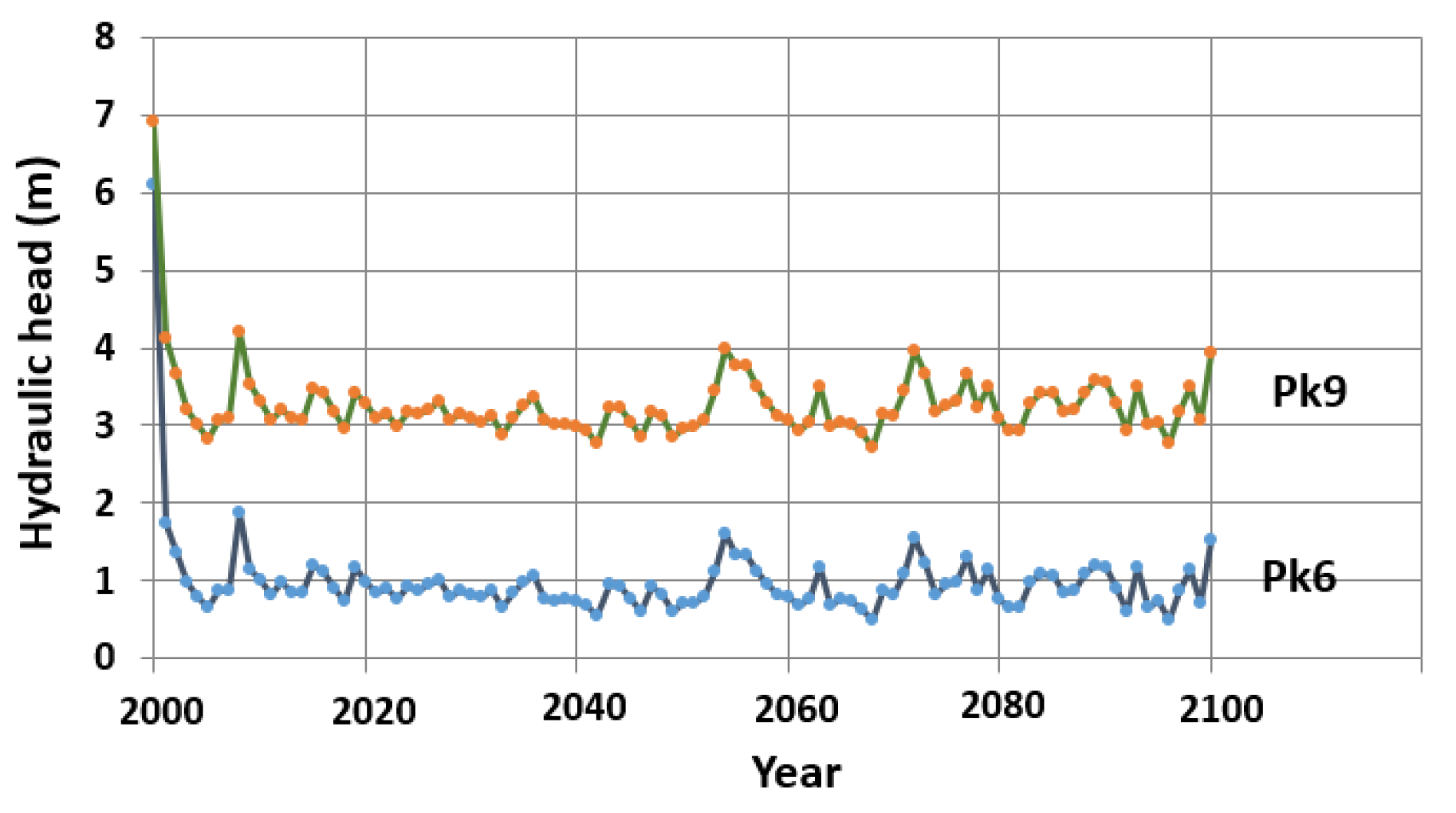
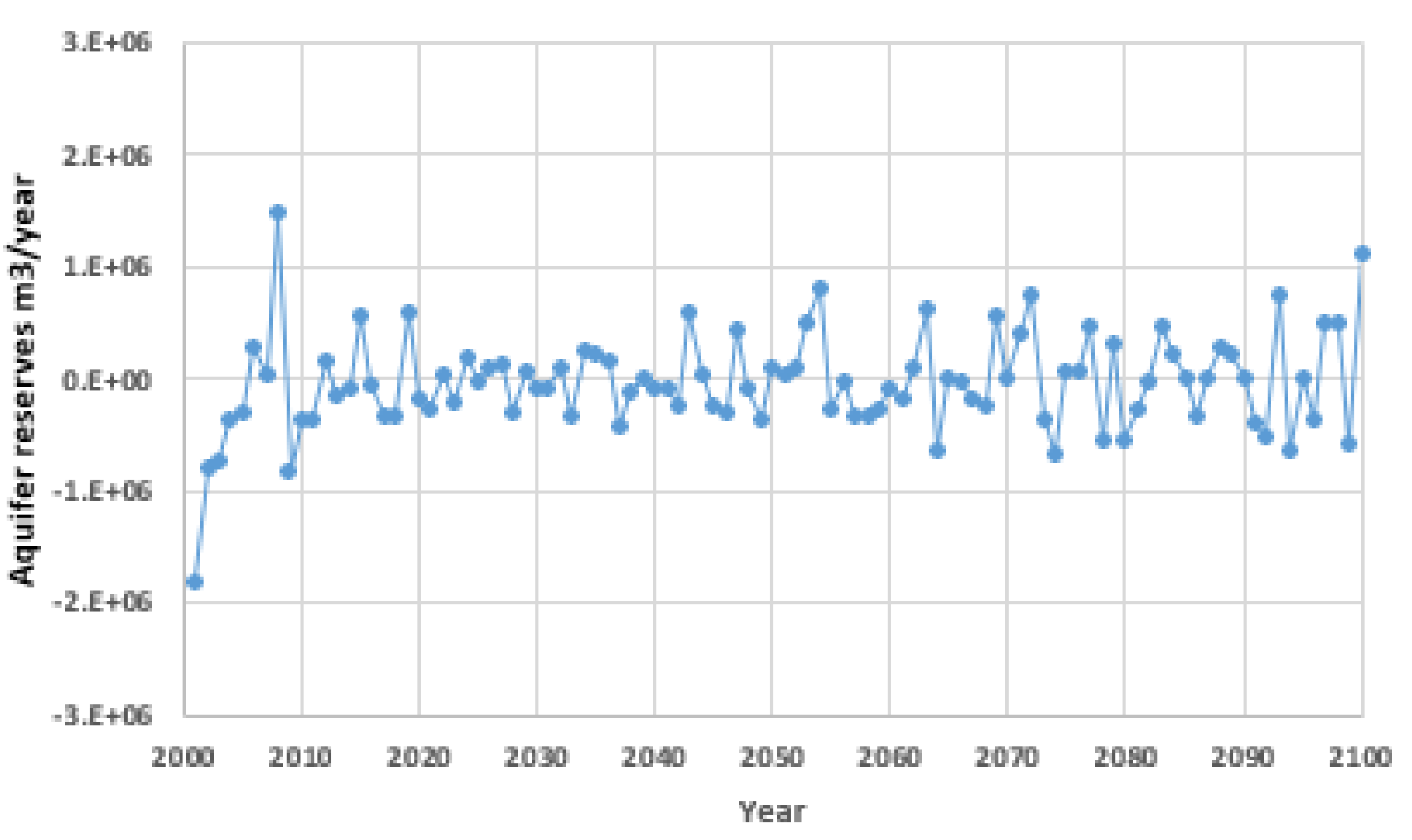

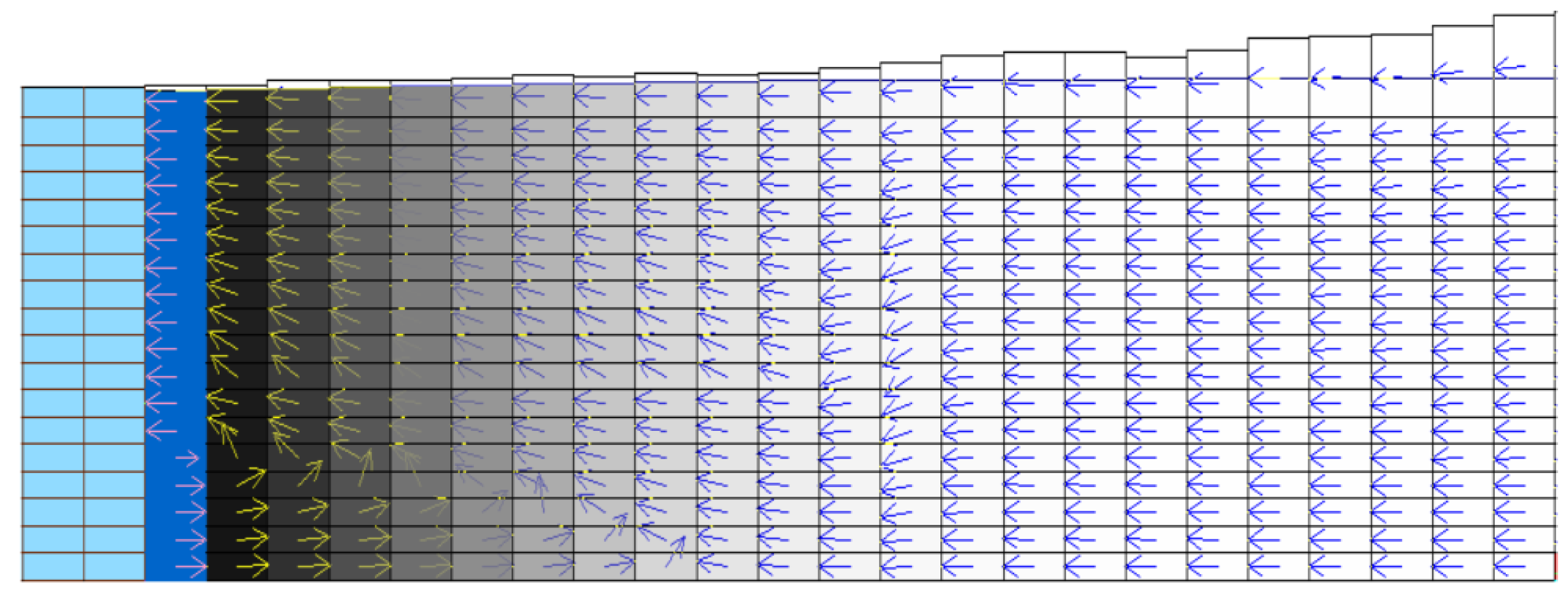
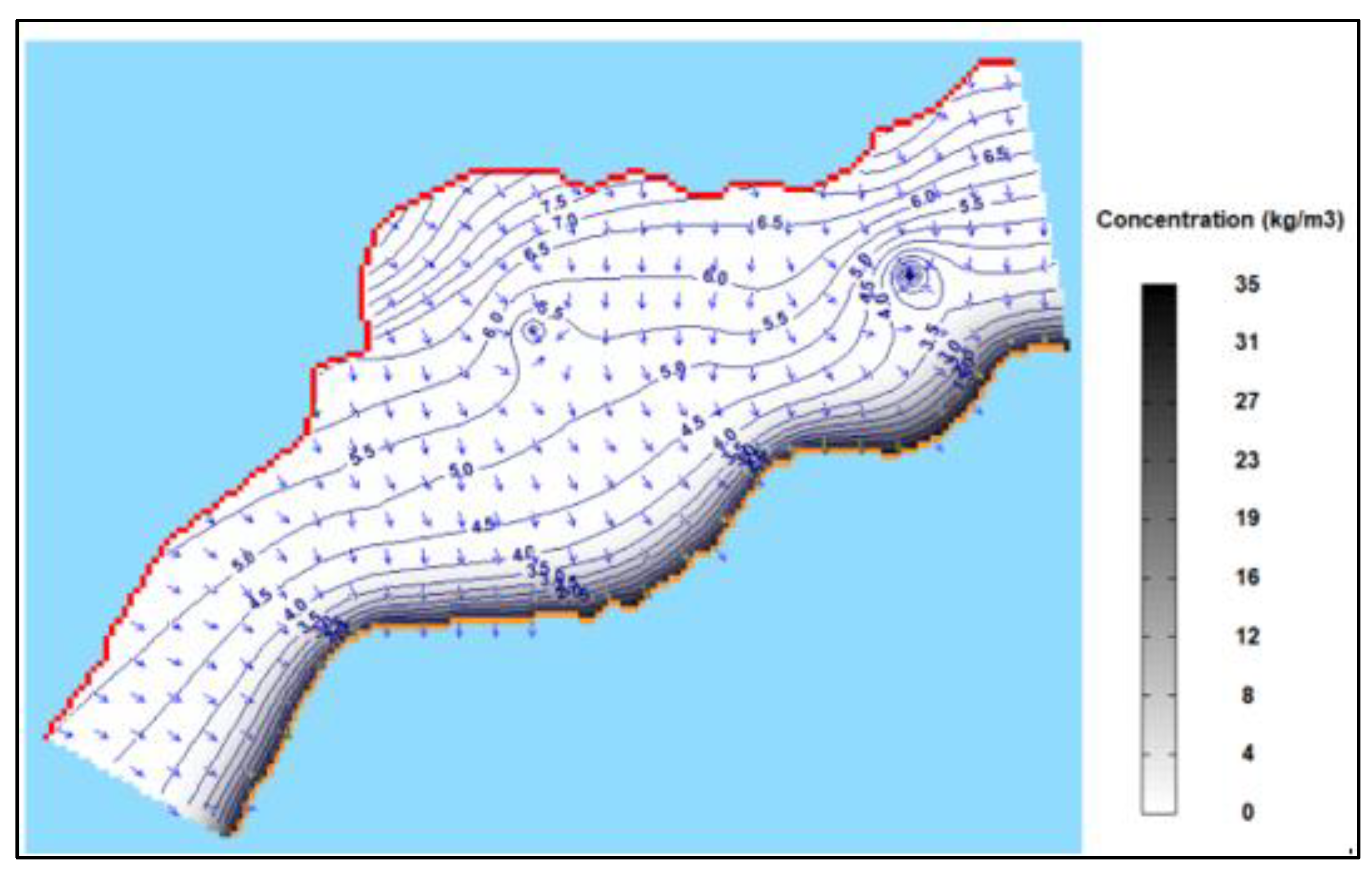
References
- Mukherjee, A.; Saha, D.; Harvey, C.F.; Taylor, R.G.; Ahmed, K.M.; Bhanja, S.N. Groundwater systems of the Indian sub-continent. J. Hydrol. Reg. Stud. 2015, 4, 1–14. [Google Scholar] [CrossRef]
- Watto, M.A.; Mugera, A.W. Econometric estimation of groundwater irrigation efficiency of cotton cultivation farms in Pakistan. J. Hydrol. Reg. Stud. 2015, 4, 193–211. [Google Scholar] [CrossRef] [Green Version]
- Jalludin, M. Groundwater ressources and challenges of future water supply of the Republic of Djibouti under arid climate (Horn of Africa). In Aquifer Systems Management; CRC Press: Dijon, France, 2006. [Google Scholar]
- Steyl, G.; Dennis, I. Review of coastal-area aquifers in Africa. Hydrogeol. J. 2010, 18, 217–225. [Google Scholar] [CrossRef]
- Ummenhofer, C.C.; Sen Gupta, A.; England, M.H.; Reason, C.J.C. Contributions of Indian Ocean sea surface temperatures to enhanced East Africanrainfall. J. Clim. 2009, 22, 993–1013. [Google Scholar] [CrossRef]
- MacDonald, A.M.; Bonsor, H.C.; Dochartaigh, B.É.Ó.; Taylor, R.G. Quantitative maps of groundwater resources in Africa. Environ. Res. Lett. 2012, 7, 024009. [Google Scholar] [CrossRef]
- Walraevens, K.; Mjemah, I.C.; Mtoni, Y.; Van Camp, M. Sources of salinity and urban pollution in the Quaternary sand aquifers of Dar es Salaam, Tanzania. J. Afr. Earth Sci. 2015, 102, 149–165. [Google Scholar] [CrossRef]
- Fetter, C.W. Applied Hydrogeology, 3rd ed.; Prentice-Hall: Englewood Cliffs, NJ, USA, 1994; p. 690. [Google Scholar]
- Bear, J.; Verruijt, A. Modeling Groundwater Flow and Pollution; D. Reidel Publishing Company: Dordrecht, The Netherlands, 1987; p. 414. [Google Scholar]
- Felisa, G.; Ciriello, V.; Di Federico, V. Saltwater Intrusion in Coastal Aquifers: A Primary Case Study along the Adriatic Coast Investigated within a Probabilistic Framework. Water 2013, 5, 1830–1847. [Google Scholar] [CrossRef] [Green Version]
- Cassardo, C.; Jones, J.A.J. Managing water in a changing world. Water 2011, 3, 618–628. [Google Scholar] [CrossRef]
- Gain, A.K.; Giupponi, C.; Renaud, F.G. Climate change adaptation and vulnerability assessment of water resources systems in developing countries: A generalized framework and a feasibility study in Bangladesh. Water 2012, 4, 345–366. [Google Scholar] [CrossRef]
- Capaccioni, B.; Didero, M.; Paletta, C.; Didero, L. Saline intrusion and refreshening in a multilayer coastal aquifer in the Catania Plain (Sicily, southern Italy): Dynamics of degradation processes according to the hydrochemical characteristics of groundwater. J. Hydrol. 2005, 307, 1–16. [Google Scholar] [CrossRef]
- De Luca, A.; Preziosi, E.; Giuliano, G.; Mastroianni, D.; Falconi, F. First evaluation of the saltwater intrusion in the Tiber delta area (Rome, central Italy). In Proceedings of the 18th Salt Water Intrusion Meeting, Cartagena, Spain, 31 May–3 June 2004; p. 34. [Google Scholar]
- Hinkel, J.; Brown, S.; Exner, L.; Nicholls, R.J.; Vafeidis, A.T.; Kebede, A.S. Sea-level rise impacts on Africa and the effects of mitigation andadaptation: An application of DIVA. Reg. Environ. Chang. 2012, 12, 207–224. [Google Scholar] [CrossRef]
- Du, X.; Lu, X.; Hou, J.; Ye, X. Improving the Reliability of Numerical Groundwater Modeling in a Data-Sparse Region. Water 2018, 10, 289. [Google Scholar] [CrossRef]
- United Nations. World Population Prospects: The 2010 Revision; UN Department of Economic and Social Affairs, Population Division: New York, NY, USA, 2011; Available online: https://www.un.org (accessed on 1 July 2019).
- MHUE (Ministère de l’Habitat, de l’Urbanisme et de l’Environnement). Ville de Tadjourah. Esquisses du Schema de Développement et D’orientation. P.71. 2013. Available online: https://www.djiboutinfo.org (accessed on 1 July 2019).
- CERD. Geological Map of Djibouti. Sheet of Tadjourah at 1/100000; CERD: Djibouti, Republic of Djibouti, 1984. [Google Scholar]
- AQUATER. Projet Pour L’évaluation des Ressources Géothermiques. AQUATER-ISERST; ISERST: Djibouti, Republic of Djibouti, 1981; Volume 2, p. 137, Unpublished Report. [Google Scholar]
- BGR (Bundesanstalt für Geowissenschaften und Rohstoffe, Hanover, Germany). Inventaire et Mise en Valeur des Ressources en eau de la République de Djibouti. [Inventory and Evaluation of the Water Resources of the Republic of Djibouti); Ministère de l’Agriculture et de l’Elevage: Djibouti, Republic of Djibouti, 1982; Volume 4, Unpublished. [Google Scholar]
- IFAGRARIA. Projet d’Aménagement d’un Périmètre Hydro-Agricole à Ambabbo—District de Tadjourah; Ministère de l’Agriculture et de l’Elevage: Djibouti, Republic of Djibouti, 1986; Unpublished. [Google Scholar]
- Abdourahman, H.G. L’aquifère côtier de Tadjourah: Synthèse des Connaissances et Modélisation en vue de la Gestion des Ressources en eau (République de Djibouti). Master’s Thesis, University of Poitiers, Poitiers, France, 2004; p. 52. Unpublished. (In French). [Google Scholar]
- Jalludin, M. Propriétés Géométriques et Hydrodynamiques des Aquifères en Milieux Volcaniques Fissurés sous Climat Aride. République de Djibouti. Ph.D. Thesis, University of Poitiers, Poitiers, France, 1993. (In French). [Google Scholar]
- Jalludin, M.; Razack, M. Analysis of pumping tests in fractured Dalha and stratiform basalts with regards to tectonics, hydrothermalisms and weathering. Republic of Djibouti. J. Hydrol. 1994, 155, 237–250. [Google Scholar] [CrossRef]
- Jalludin, M.; Razack, M. Assessment of hydraulic properties of sedimentary and volcanic aquifer systems under arid conditions in the Republic of Djibouti (Horn of Africa). Hydrogeol. J. 2004, 12, 159–170. [Google Scholar] [CrossRef]
- Gamal-Eldin, H.A. Etude de l’aquifère Basaltique de la Zone de Captage de la Ville de Djibouti. République de Djibouti. Ph.D. Thesis, University Albert-Ludwig, Fribourg, Germany, 1988. Unpublished. [Google Scholar]
- Medjerab, A. Les situations pluviométriques extrêmes dans le nord-ouest de l’Algérie. In Climat, Tourisme, Environnement; Actes du XXème Colloque de l’Association Internationale de Climatologie: Carthage, Tunisie, 2007; pp. 381–386. [Google Scholar]
- Gee, G.W.; Hillel, D. Groundwater recharge in arid regions: Review and critique of estimation its methods. Hydrol. Process. 1988, 2, 255–266. [Google Scholar] [CrossRef]
- Nimmo, J.R.; Horowitz, C.; Mitchell, L. Discrete-Storm Water-Table Fluctuation Method to Estimate Episodic Recharge. Groundwater 2015, 53, 282–292. [Google Scholar] [CrossRef]
- Zhang, J.; Felzer, B.S.; Troy, T.J. Extreme precipitation drives groundwater recharge: The Northern High Plains Aquifer, central United States, 1950–2000. Hydrol. Process. 2016, 30, 2533–2545. [Google Scholar] [CrossRef]
- Thomas, B.F.; Ali Behrangi, A.; Famiglietti, J.S. Precipitation Intensity Effects on Groundwater Recharge in the Southwestern United States. Water 2016, 8, 90. [Google Scholar] [CrossRef]
- Giorgi, F.; Francisco, R. Evaluating uncertainties in the prediction of regional climate change. Geophys. Lett. 2000, 27, 1295–1298. [Google Scholar] [CrossRef]
- Aggarwal, P.K.; Mall, R.K. Climate Change and Rice Yields in Diverse Agro-Environments of India. II. Effect of Uncertainties in Scenarios and Crop Models on Impact Assessment. Clim. Chang. 2002, 52, 331–343. [Google Scholar] [CrossRef]
- Velázquez, J.A.; Schmid, J.; Ricard, S.; Muerth, M.; St-Denis, B.G.; Minville, M.; Chaumont, D.; Caya, D.; Ludwig, R.; Turcotte, R. An ensemble approach to assess hydrological models’ contribution to uncertainties in the analysis of climate change impact on water resources. Hydrol. Earth Sci. 2013, 17, 565–578. [Google Scholar] [CrossRef]
- Kum, D.; Lim, K.J.; Jang, C.H.; Ryu, J.; Yang, J.E.; Kim, S.J.; Kong, D.S.; Jung, Y. Projecting Future Climate Change Scenarios Using Three Bias-Correction Methods. Adv. Meteorol. 2014, 2014, 1–12. [Google Scholar] [CrossRef]
- IPCC. Climate Change 2014: Synthesis Report. Contribution of Working Groups I, II and III to the Fifth Assessment Report of the Intergovernmental Panel on Climate Change; Core Writing Team, Pachauri, R.K., Meyer, L.A., Eds.; IPCC: Geneva, Switzerland, 2014; p. 151. Available online: https://archive.ipcc.ch/pdf/assessment-report/ar5 (accessed on 1 July 2019).
- Lee, J.M.; Jung, Y.; Park, Y.; Kang, H.; Lim, K.J.; Kim, H. Assessment of Future Climate Change Impact on Groundwater recharge, Baseflow and Sediment in Steep SlopingWatershed. J. Wetl. 2014, 16, 173–185. [Google Scholar] [CrossRef]
- Fiseha, B.M.; Setegn, S.G.; Melesse, A.M.; Volpi, E.; Fiori, A. Impact of Climate Change on the Hydrology of Upper Tiber River Basin Using Bias Corrected Regional Climate Model. Water Resour. Manag. 2014, 28, 1327–1343. [Google Scholar] [CrossRef]
- Verma, S.; Bhattarai, R.; Bosch, N.S.; Cooke, R.C.; Kalita, P.K.; Markus, M. Climate Change Impacts on Flow, Sediment and Nutrient Export in a Great Lakes Watershed Using SWAT. CLEAN Soil Air Water 2015, 43, 1464–1474. [Google Scholar] [CrossRef]
- Mastrocicco, M.; Busico, G.; Colombani, N.; Vigliotti, M.; Ruberti, D. Modelling Actual and Future Seawater Intrusion in the Variconi CoastalWetland (Italy) Due to Climate and Landscape Changes. Water 2019, 11, 1502. [Google Scholar] [CrossRef]
- Langevin, C.D.; Shoemaker, B.; Guo, W. Documentation of the SEAWAT-2000 Version with the Variable-Density Flow Process (VDF) and the Integrated MT3DMS Transport Process (IMT); Open File Report 03-426; United States Geological Survey: Tallahassee, FL, USA, 2003; p. 44. [Google Scholar]
- McDonald, M.G.; Harbaugh, A.W. A Modular Three-Dimensional Finite-Difference Ground-Water Flow Model; Survey Techniques of Water Resources Investigations; U.S. Geological Survey: Reston, VA, USA, 1988; p. 586. [Google Scholar]
- Zheng, C. MT3D-A Modular Three-Dimensional Transport Model for Simulation of Advection, Dispersion and Chemical Reactions of Contaminants in Groundwater Systems; S.S. Papadopulos & Associates, Inc.: Bethesda, MD, USA, 1996. [Google Scholar]
- Rao, S.V.N.; Sreenivasulu, V.; Bhallamudi, S.M.; Thandaveswara, B.S.; Sudheer, K.P. Planning groundwater development in coastal aquifers. Hydrol. Sci. J. 2004, 49, 155–170. [Google Scholar] [CrossRef]
- Moustadraf, J.; Razack, M.; Sinan, M. Evaluation of the impacts of climate changes on the coastal Chaouia aquifer, Morocco, using numerical modeling. Hydrogeol. J. 2008, 7, 1411–1426. [Google Scholar] [CrossRef]
- Schneider, J.C.; Kruse, S.E. A comparison of controls on freshwater lens morphology of small carbonate and siliciclastic islands: Examples from barrier islands in Florida, USA. J. Hydrol. 2003, 284, 253–269. [Google Scholar] [CrossRef]
- Bonte1, M.; Biesheuvel, A. The application of the SEAWAT variable density code for the Lake Wieringen project, the Netherlands. In Proceedings of the 1st SWIM-SWICA Joint Saltwater Intrusion Conference, Cagliari-Chia Laguna, Italy, 24–29 September 2006; pp. 45–52. [Google Scholar]
- Qahman, K.; Larabi, A. Evaluation and numerical modeling of seawater intrusion in the Gaza aquifer (Palestine). Hydrogeol. J. 2006, 14, 713–728. [Google Scholar] [CrossRef]
- Al-Maktoumi, A.; Lockington, D.A.; Volker, R.E. SEAWAT 2000: Modelling unstable flow and sensitivity to discretization levels and numerical schemes. Hydrogeol. J. 2007, 15, 1119–1129. [Google Scholar] [CrossRef]
- Bauer, P.; Held, R.J.; Zimmermann, S.; Linn, F.; Kinzelbach, W. Coupled flow and salinity transport modelling in semi-arid environments: The Shashe River Valley, Botswana. J. Hydrol. 2006, 316, 163–183. [Google Scholar] [CrossRef]
- Anderson, M.P.; Woessner, W.M. Applied Groundwater Modelin; Academic Press: San Diego, CA, USA, 1992; p. 381. [Google Scholar]
- Hoovera, D.J.; Odigiea, K.O.; Swarzenskia, P.W.; Barnarda, P. Sea-level rise and coastal groundwater inundation and shoaling at select sites in California, USA. J. Hydrol. Reg. Stud. 2017, 11, 234–249. [Google Scholar] [CrossRef] [Green Version]
- Cayan, D.R.; Bromirski, P.D.; Hayhoe, K.; Tyree, M.; Dettinger Flick, R.E. Climate change projections of sea level extremes along the California coast. Clim. Chang. 2008, 87, S57–S73. [Google Scholar] [CrossRef]
- MHUE. (Ministère de l’Habitat, de l’Urbanisme et de l’Environnement). Seconde Communication Nationale de la République de Djibouti à la Convention Cadre des Nations Unies Sur les Changements Climatiques (Second National Communication of the Republic of Djibouti to the United Nations Convention on Climate Change). 2013. Available online: http://www.environnement.dj/ (accessed on 1 May 2019). (In French).
- Sherif, M.; Singh, V.P. Effect of climate change on sea water intrusion in coastal aquifers. Hydrol. Process. 1999, 13, 1277–1287. [Google Scholar] [CrossRef]
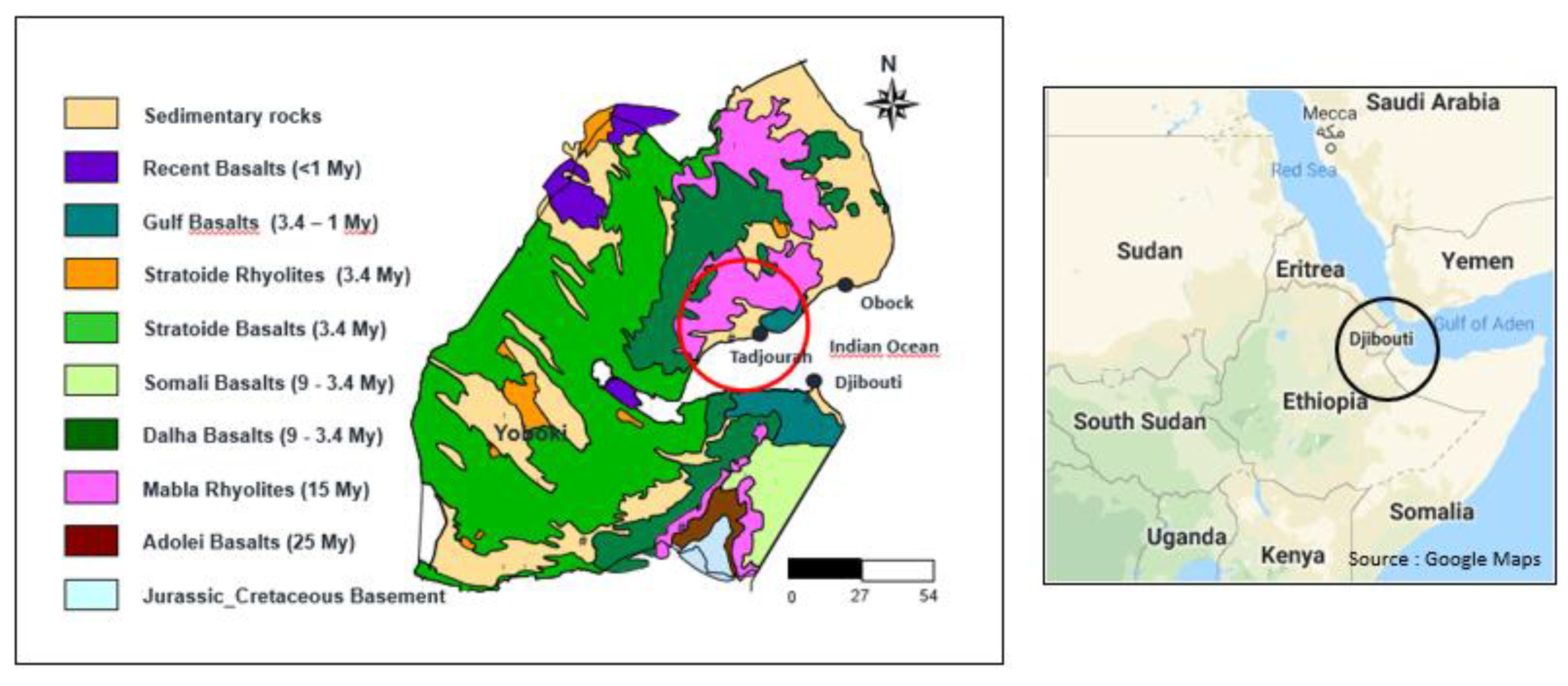
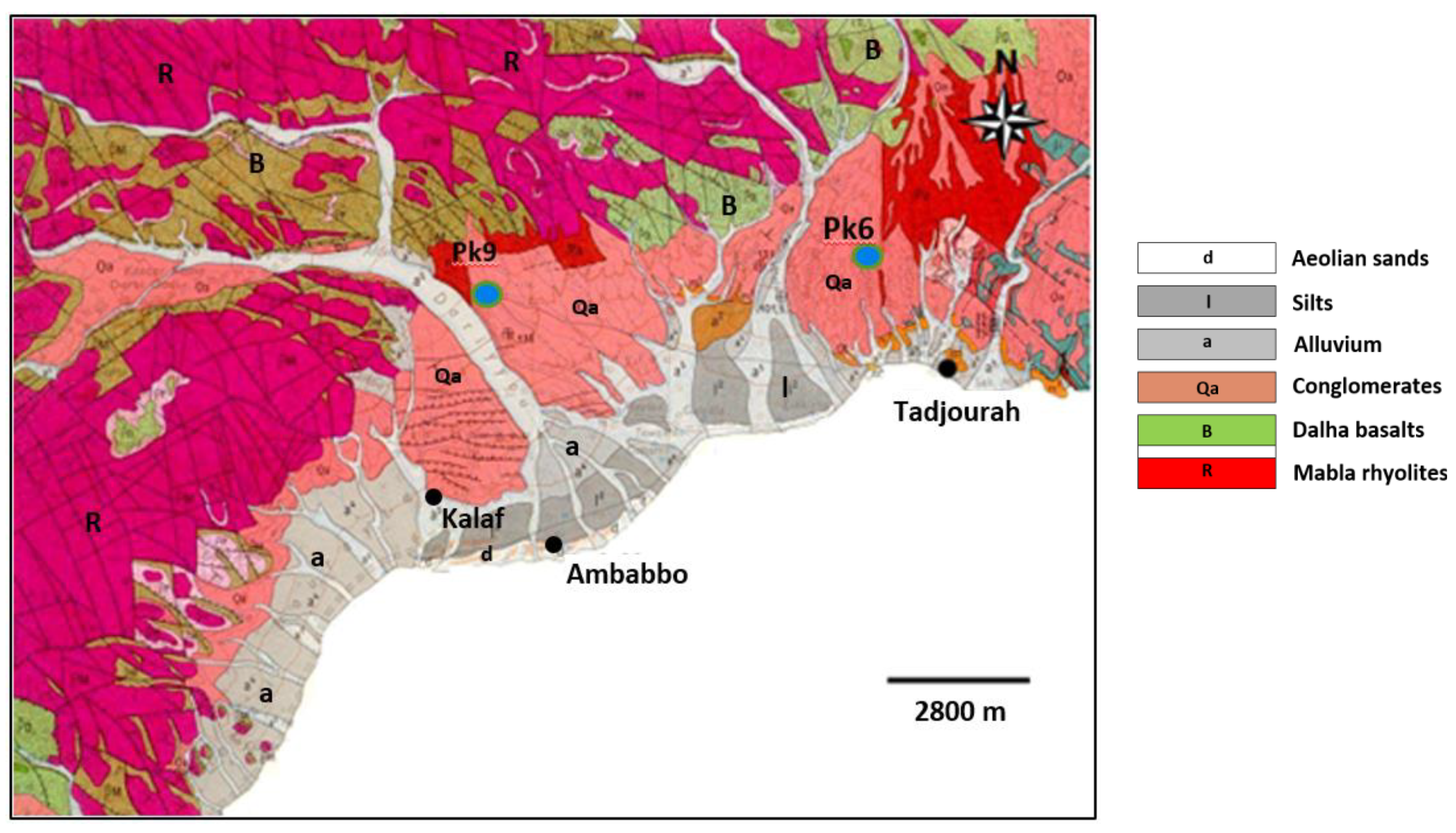
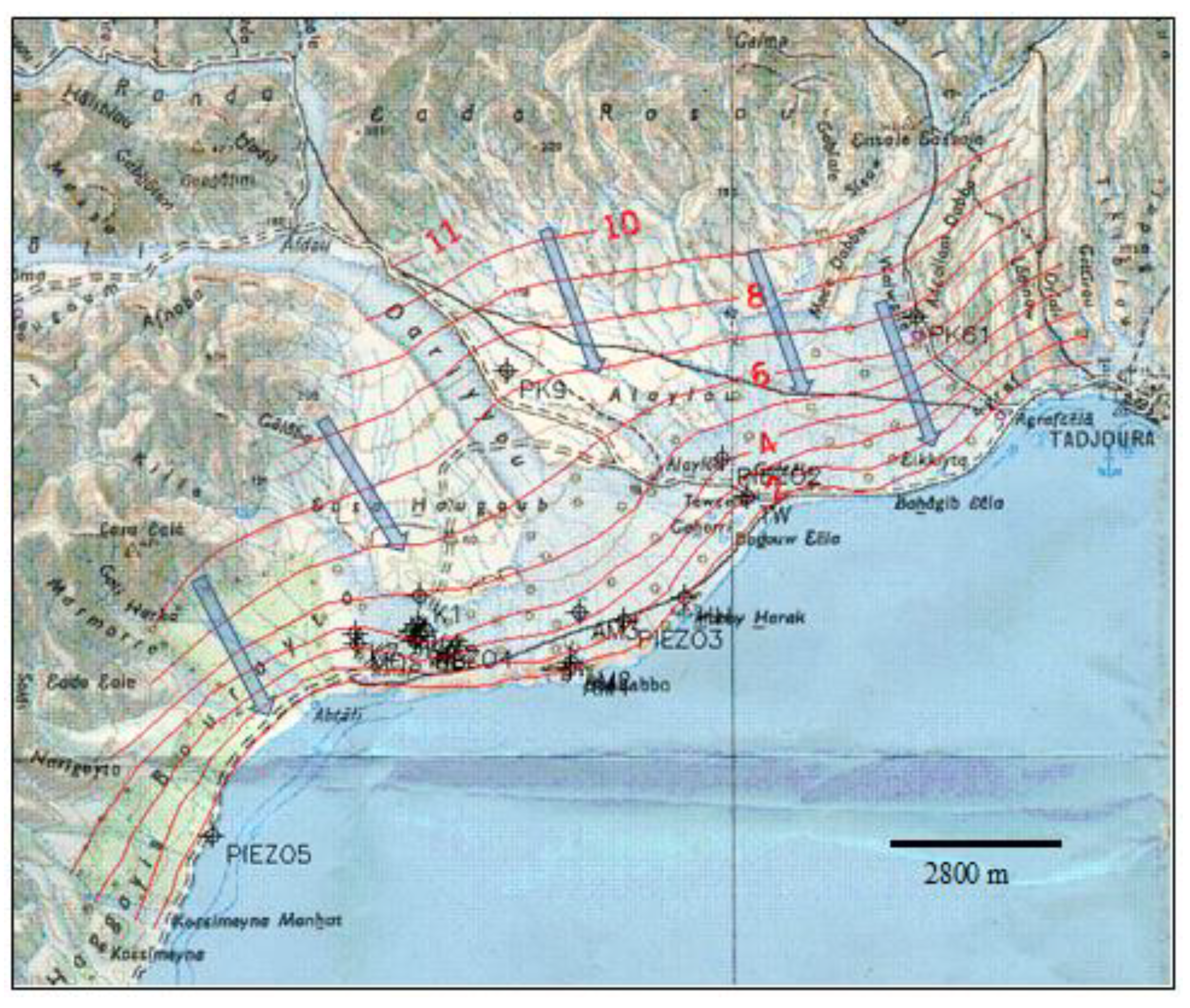
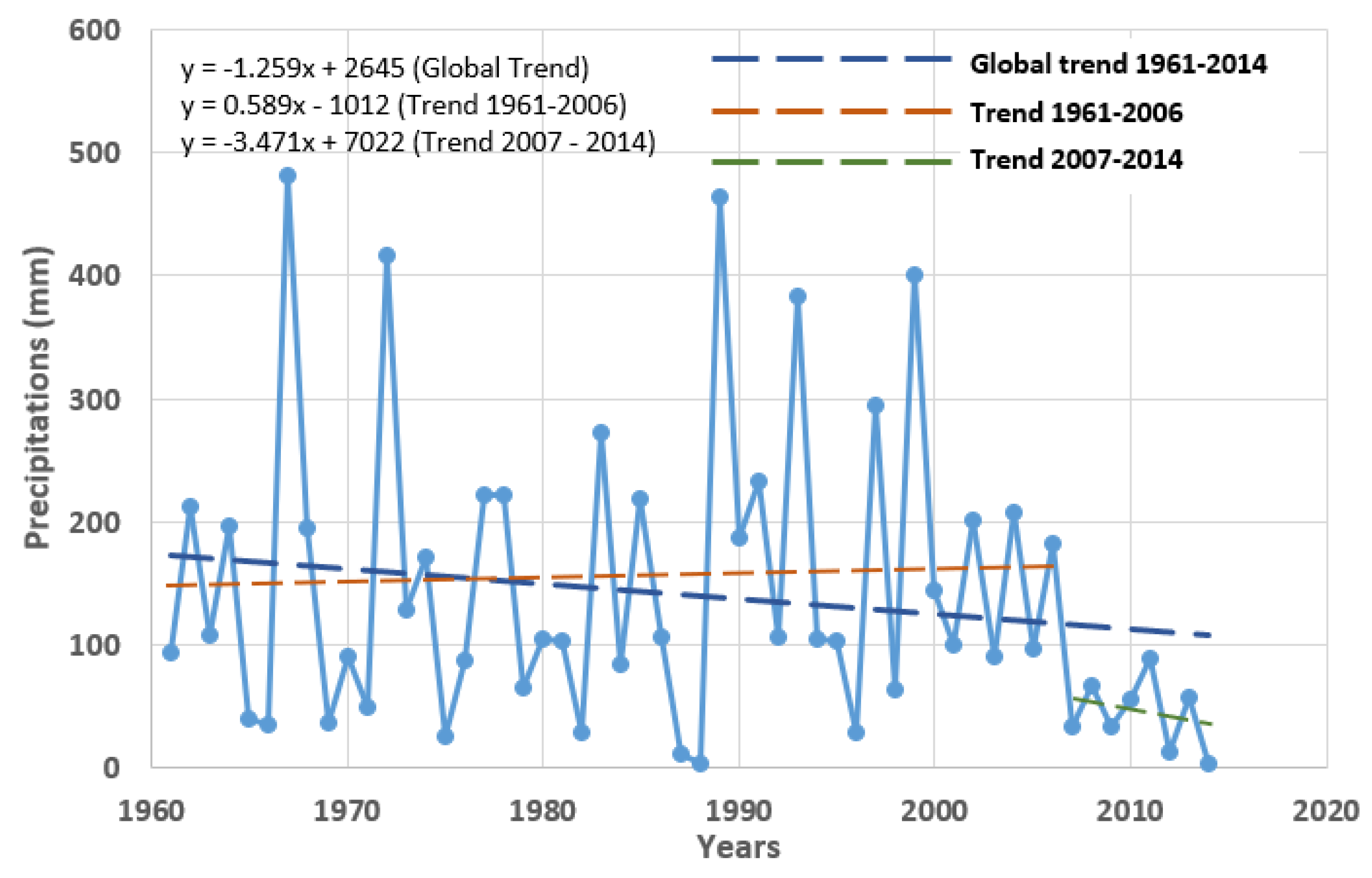
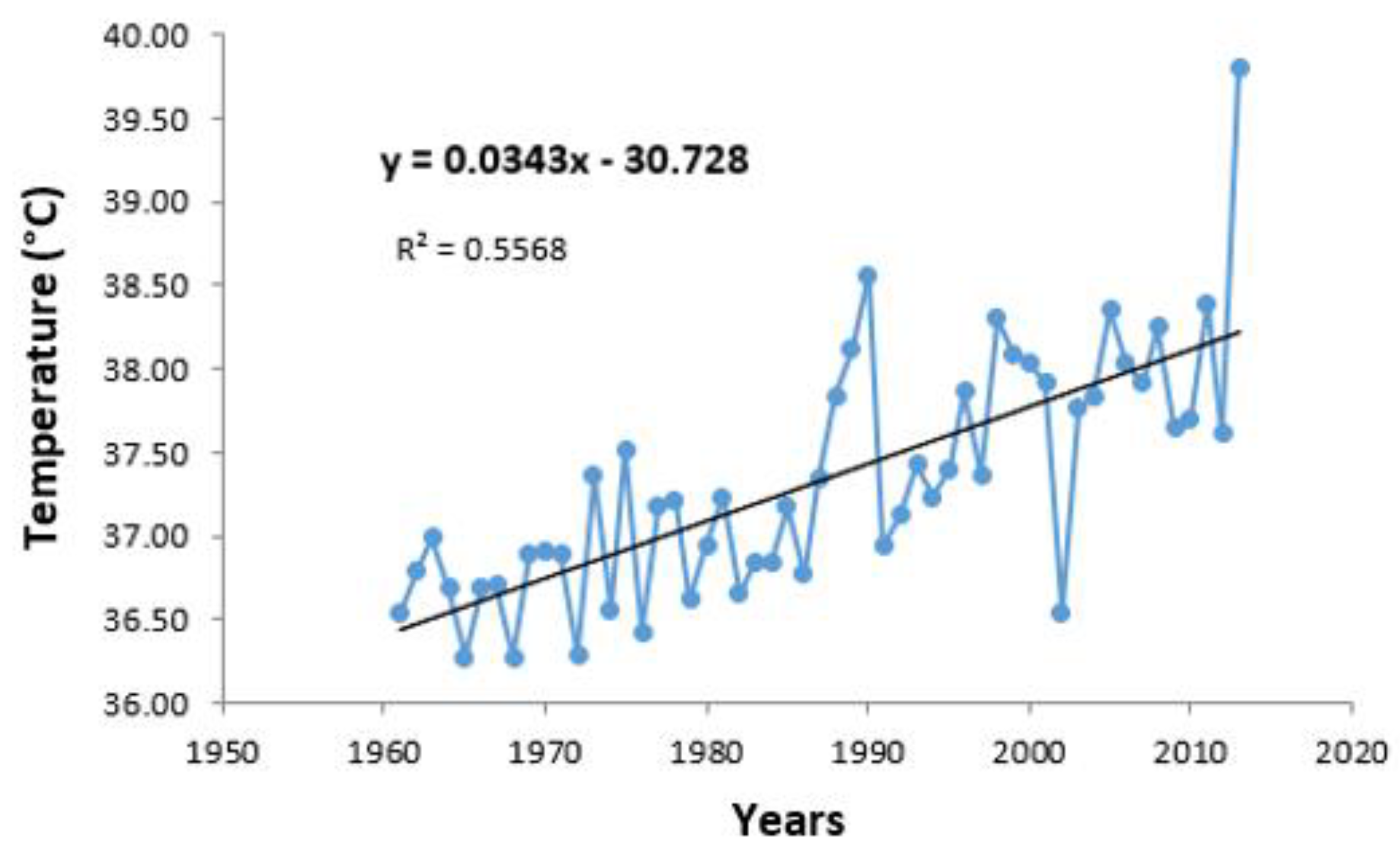
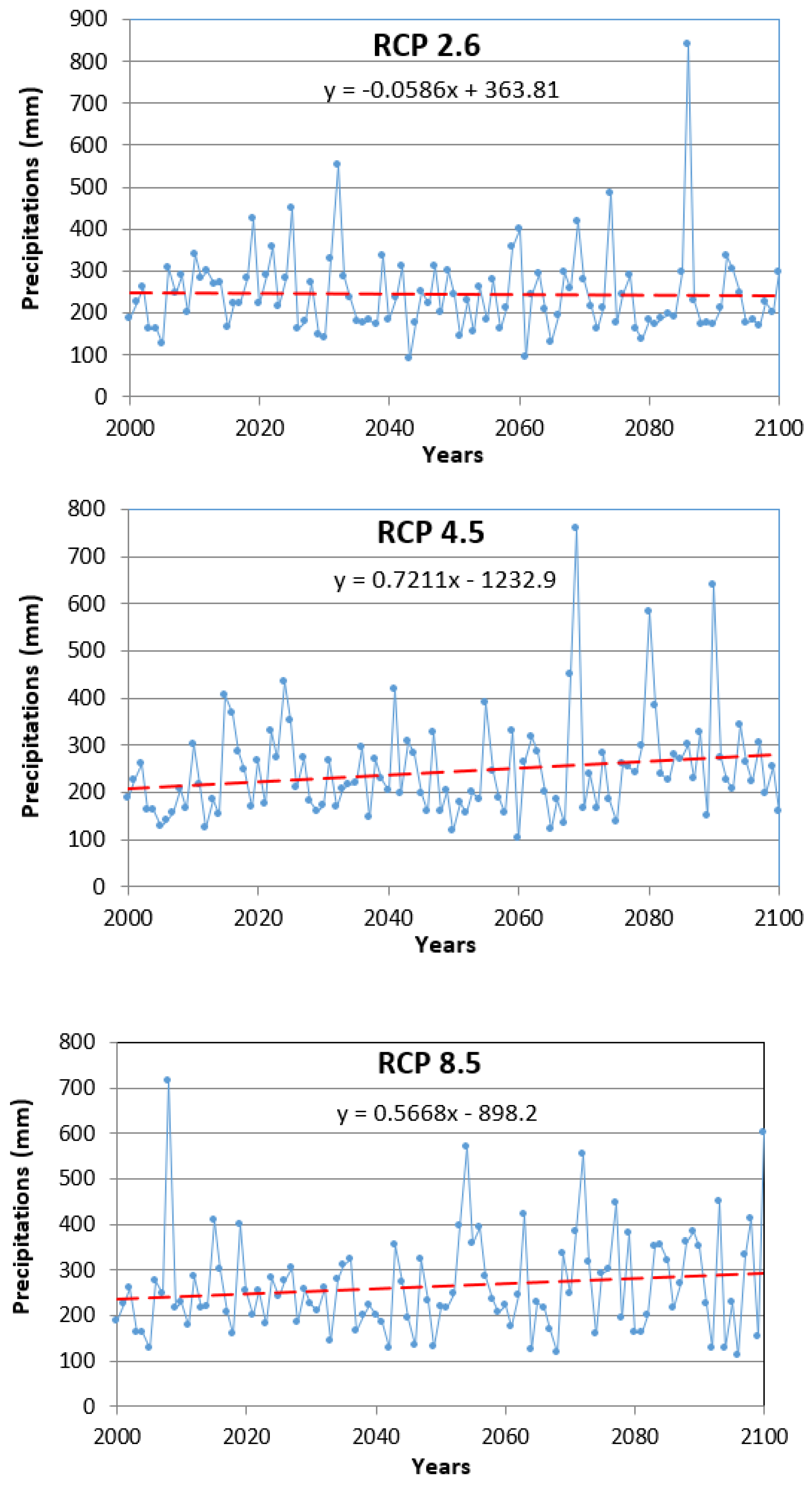
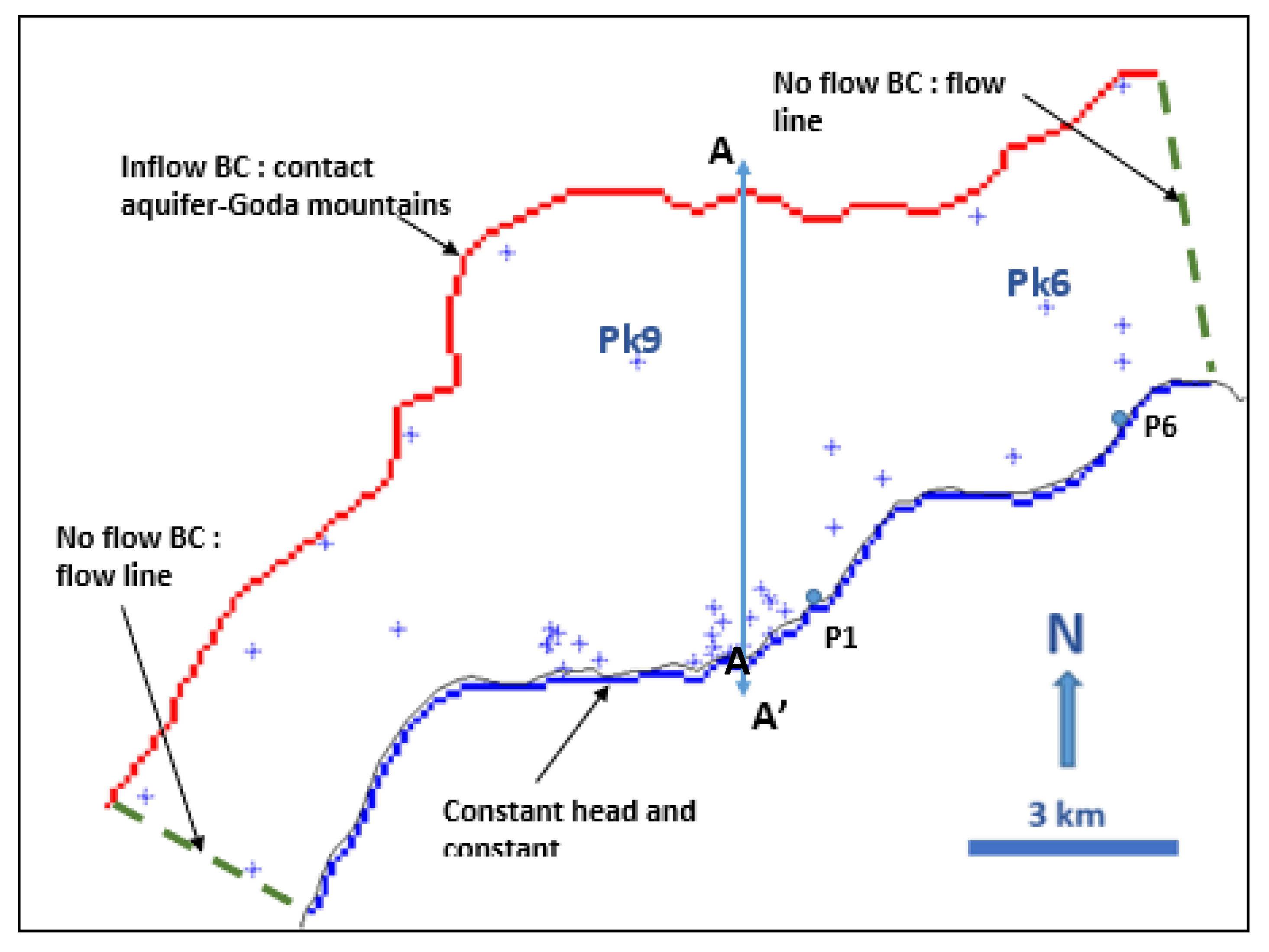
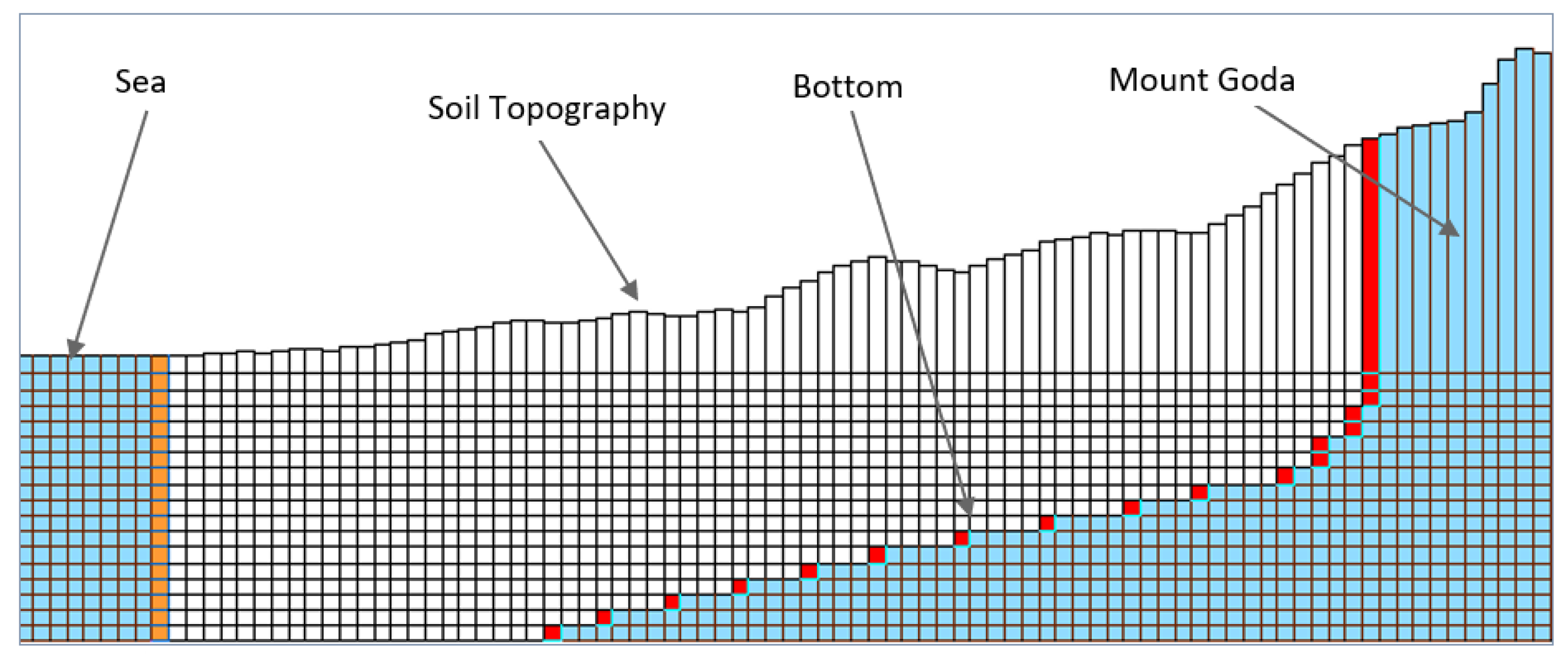

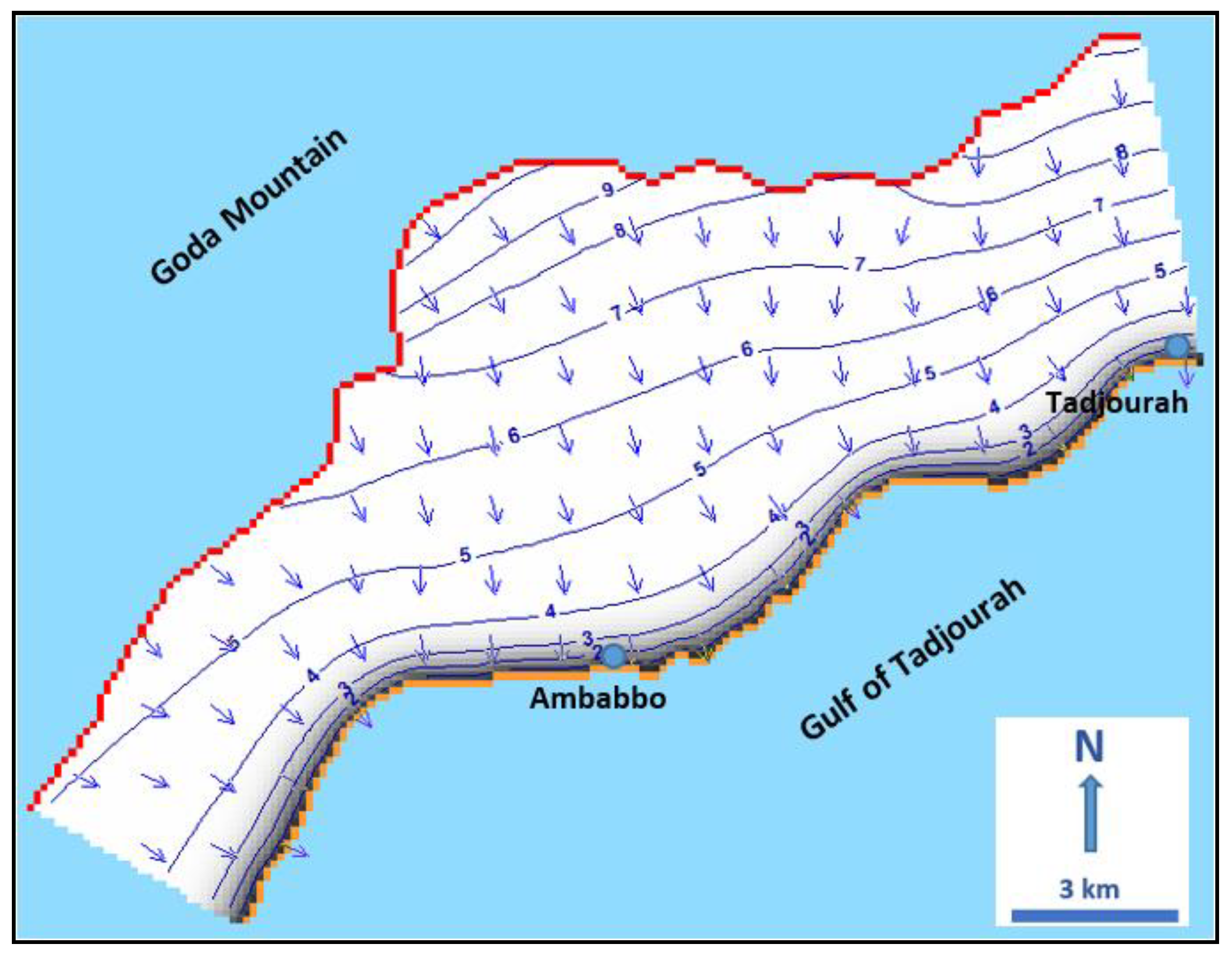
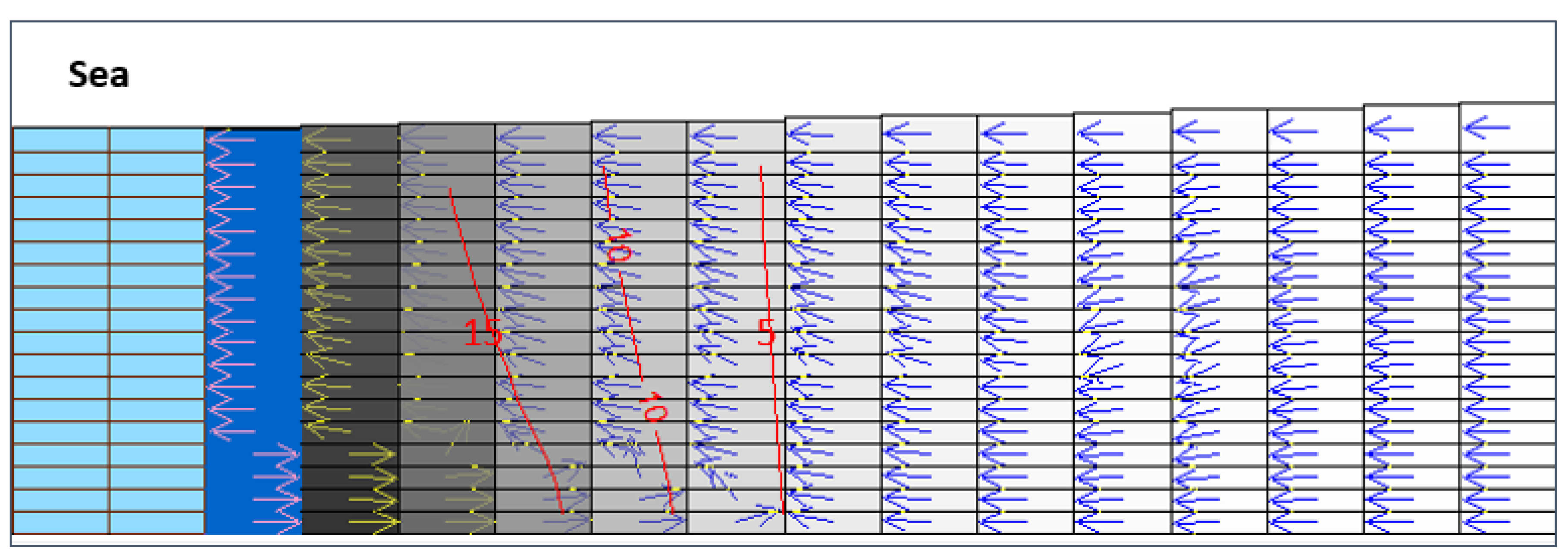
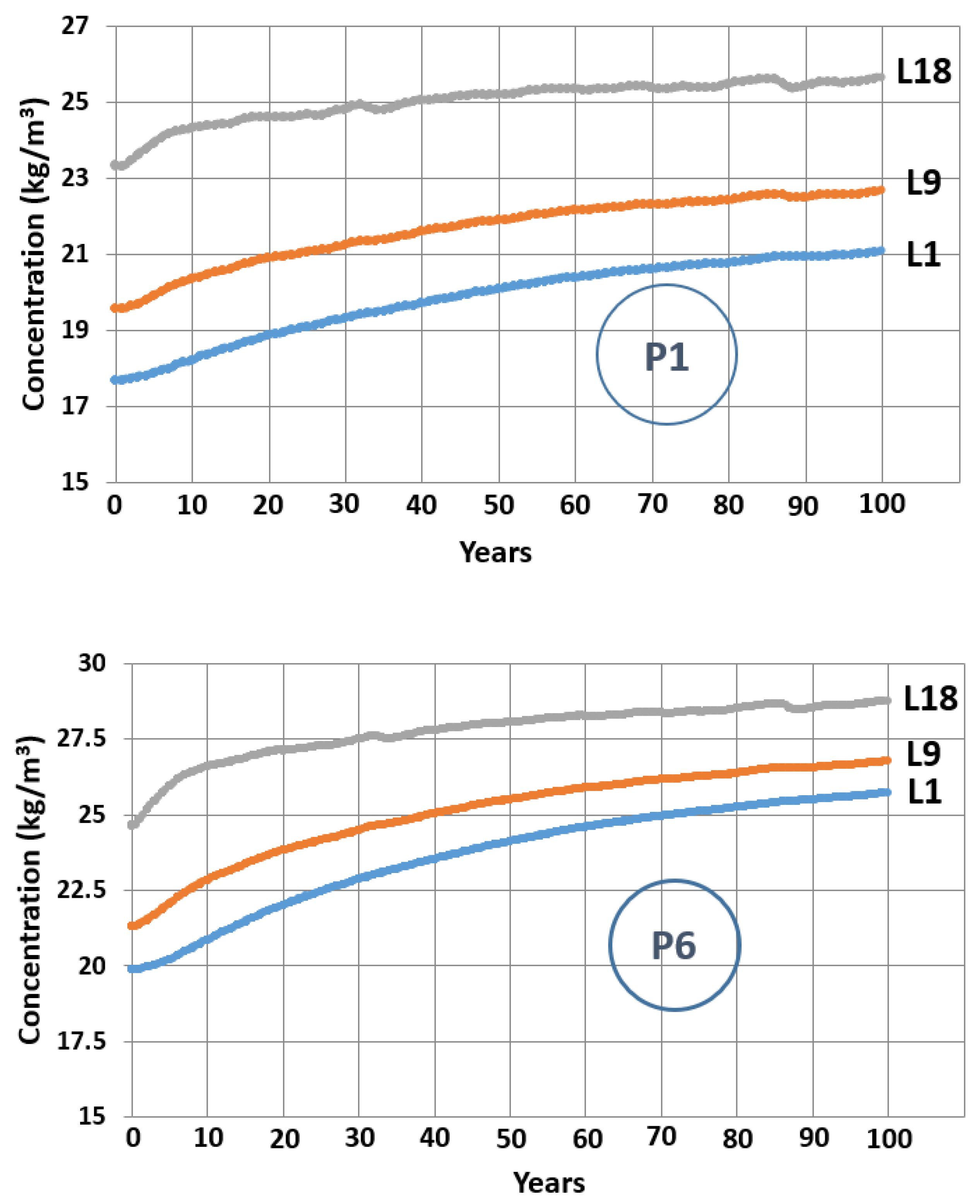
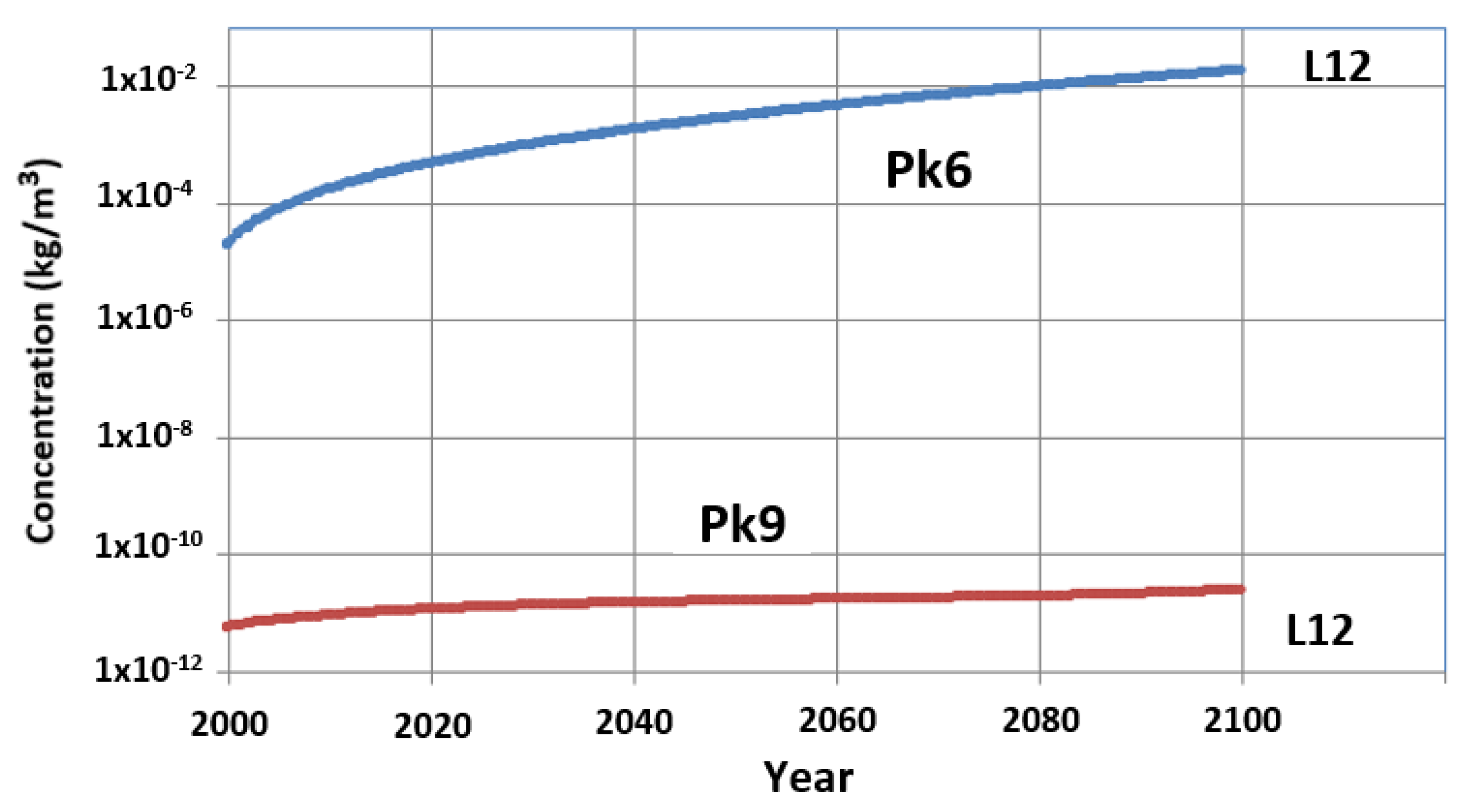
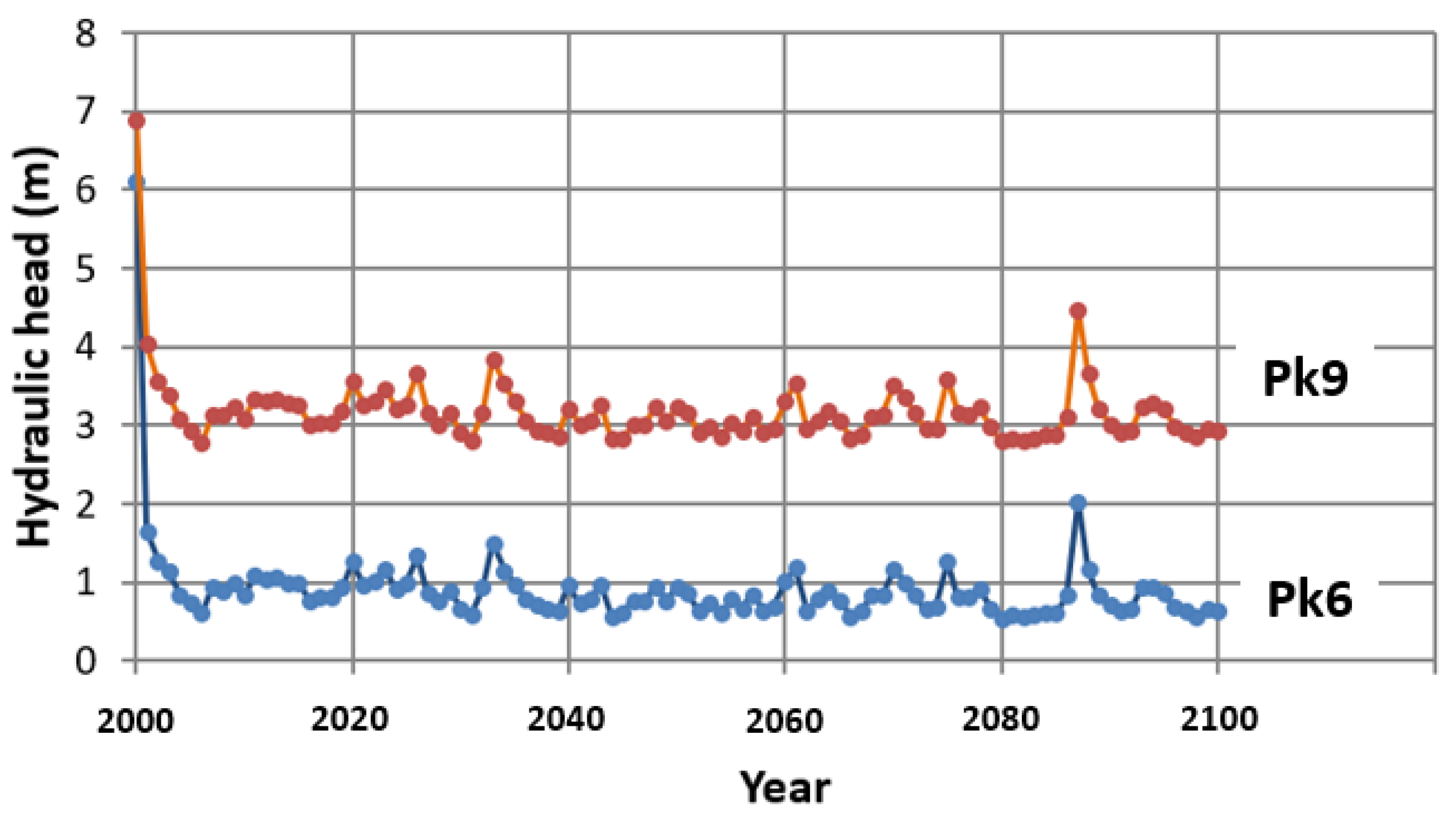
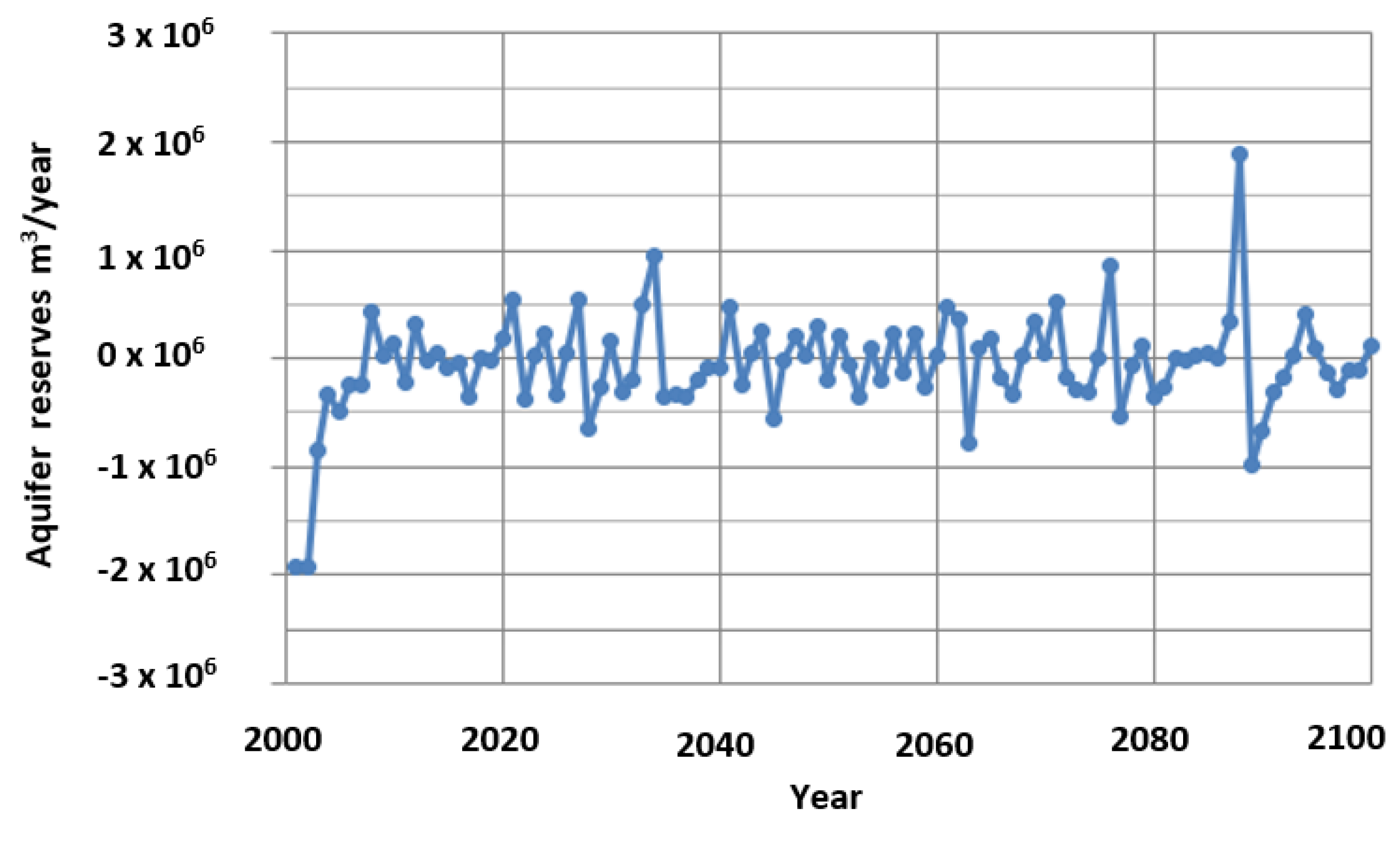
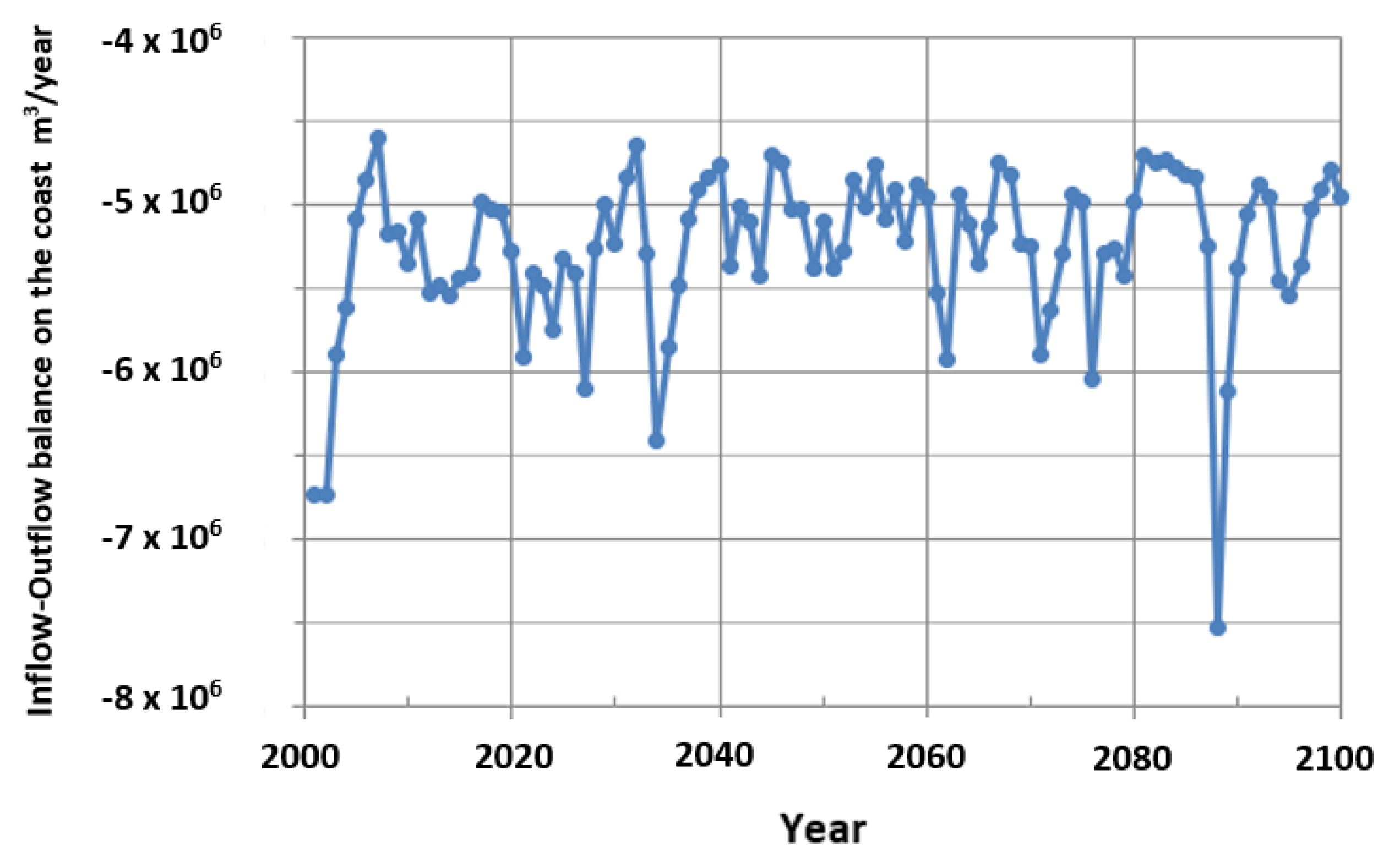
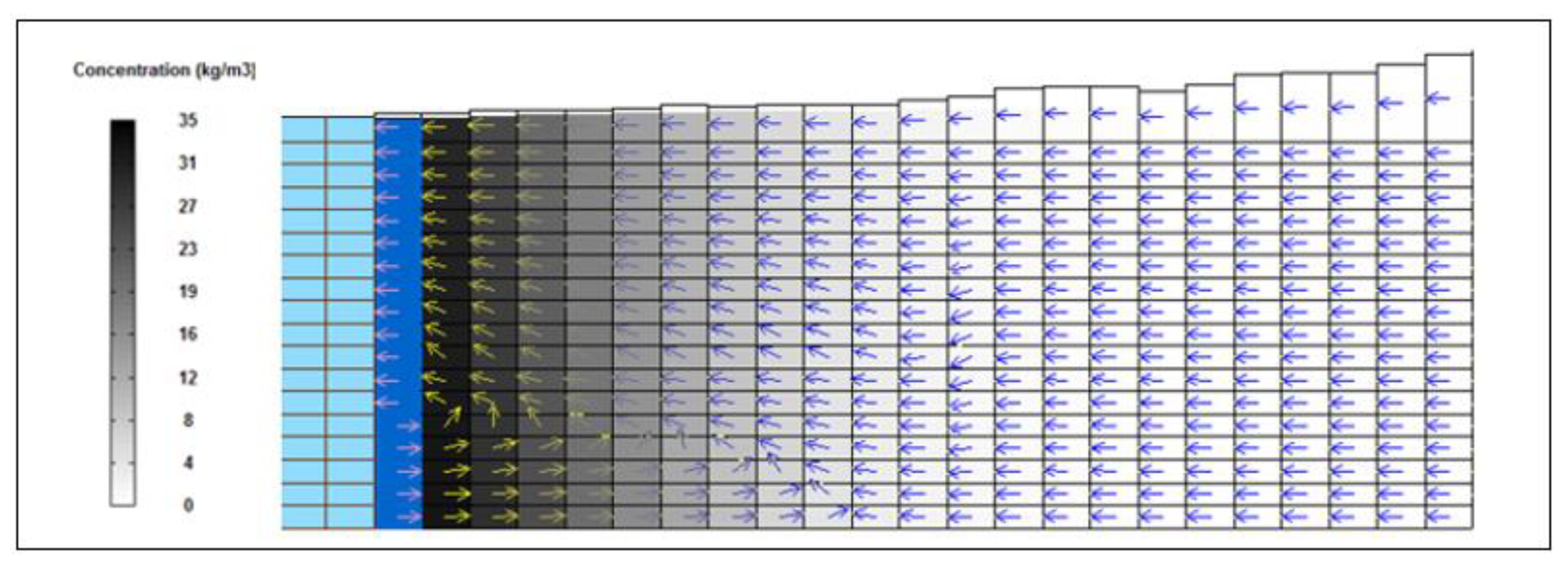
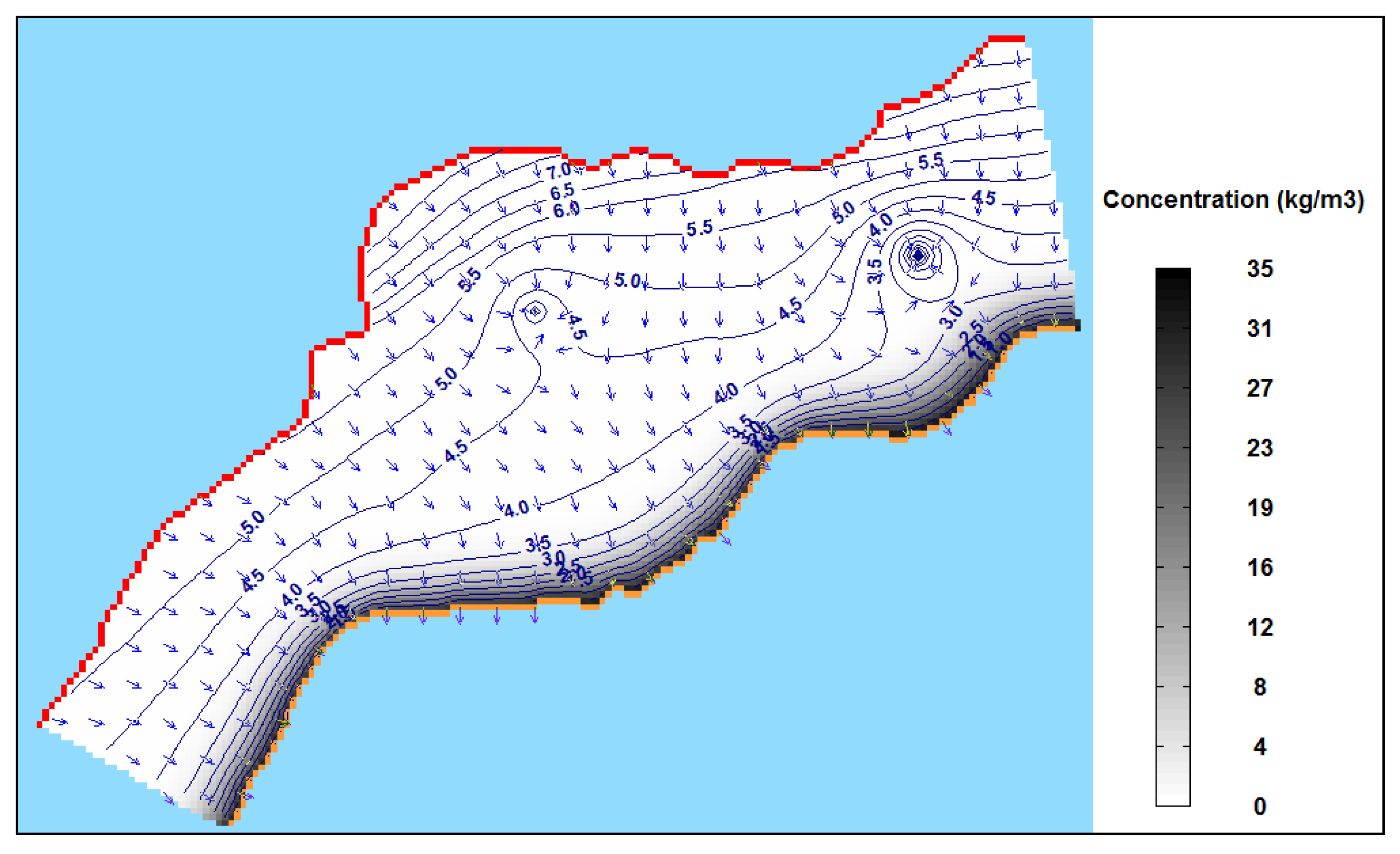
| Component (m3/year) | Inflow | Outflow |
|---|---|---|
| Surficial Recharge | 4.5 × 105–6.5 × 105 | -- |
| Seashore | ? | ? |
| Upstream Limit with Mount Goda | 1.8 × 106–2.7 × 106 | -- |
| Well | T (m2/d) | K (m/d) |
|---|---|---|
| PK6 | 216 | 1.1 |
| PK9 | 605 | 3.0 |
| Min (mm) | Max (mm) | Average (mm) | SD (mm) | CV (%) | |
|---|---|---|---|---|---|
| Whole series 1961–2014 | 3 | 481 | 146 | 122 | 84 |
| Subseries 1961–2006 | 3 | 481 | 156 | 121 | 77 |
| Subseries 2007–2014 | 3 | 89 | 44 | 28 | 65 |
| Scenario | RCP 2.6 | RCP 4.5 | RCP 8.5 |
|---|---|---|---|
| Average (mm) CI (95%) | 243.7 224 < m < 263 | 245.3 224 < m < 265 | 263.8 242 < m < 285 |
| Minimum (mm) | 91.7 | 102.2 | 111.3 |
| Maximum (mm) | 841.2 | 758.8 | 716.3 |
| SD (mm) | 100.6 | 105.1 | 108.9 |
| CV (%) | 41.3 | 42.8 | 41.3 |
| Component (m3/year) | Inflow | Outflow | Inflow−Outflow |
|---|---|---|---|
| Surficial Recharge | 6.48 × 105 | 6.48 × 105 | |
| Limit corresponding to the sea | 1.41 × 106 | 4.27 × 106 | −2.86 × 106 |
| Upstream Limit with Mount Goda | 2.26 × 106 | 2.26 × 106 | |
| Storage | 4.88 × 102 | 1.42 × 104 | −1.37 × 104 |
| TOTAL | 4.32 × 106 | 4.29 × 106 | 3.14 × 104 |
© 2019 by the authors. Licensee MDPI, Basel, Switzerland. This article is an open access article distributed under the terms and conditions of the Creative Commons Attribution (CC BY) license (http://creativecommons.org/licenses/by/4.0/).
Share and Cite
Razack, M.; Jalludin, M.; Houmed-Gaba, A. Simulation of Climate Change Impact on A Coastal Aquifer under Arid Climate. The Tadjourah Aquifer (Republic of Djibouti, Horn of Africa). Water 2019, 11, 2347. https://doi.org/10.3390/w11112347
Razack M, Jalludin M, Houmed-Gaba A. Simulation of Climate Change Impact on A Coastal Aquifer under Arid Climate. The Tadjourah Aquifer (Republic of Djibouti, Horn of Africa). Water. 2019; 11(11):2347. https://doi.org/10.3390/w11112347
Chicago/Turabian StyleRazack, Moumtaz, Mohamed Jalludin, and Abdourahman Houmed-Gaba. 2019. "Simulation of Climate Change Impact on A Coastal Aquifer under Arid Climate. The Tadjourah Aquifer (Republic of Djibouti, Horn of Africa)" Water 11, no. 11: 2347. https://doi.org/10.3390/w11112347
APA StyleRazack, M., Jalludin, M., & Houmed-Gaba, A. (2019). Simulation of Climate Change Impact on A Coastal Aquifer under Arid Climate. The Tadjourah Aquifer (Republic of Djibouti, Horn of Africa). Water, 11(11), 2347. https://doi.org/10.3390/w11112347






